Research on the Effective Sheltering Rates of Public Buildings in Villages in Western Sichuan, China—A Case Study of Ganbao Tibetan Village
Abstract
1. Introduction
2. Research Subjects and Methods
2.1. Research Subjects
2.2. Research Methods
2.3. Basis for Indicator Values
2.3.1. Basis for Indicator Values of Post-Disaster Conversion of Public Buildings
2.3.2. Basis for Shelter Area Calculation
3. Selection of Sheltering Buildings and Calculation Results of Effective Sheltering Rate
3.1. Field Survey Results of Public Service Buildings in Ganbao Tibetan Village
3.2. Selection of Shelter Buildings in Ganbao Tibetan Village
3.3. Calculation Results of Effective Sheltering Rates for Ganbao Tibetan Village’s Sheltering Buildings
4. Strategies for Improving the Efficiency of Post-Disaster Conversion of Public Service Buildings
4.1. Strategies to Enhance the Effective Sheltering Rate in Typical Small Spaces of Ganbao Tibetan Village
4.2. Strategies to Enhance Effective Sheltering Rates in Typical Large Spaces in Ganbao Tibetan Village
5. Conclusions
Author Contributions
Funding
Data Availability Statement
Conflicts of Interest
References
- Strong Earthquakes in Sichuan and their Distribution. Available online: https://www.scdzj.gov.cn/dzpd/dzkp/202201/t20220125_51277.html (accessed on 11 June 2024). (In Chinese)
- Luo, Y.H.; Fan, X.M.; Huang, R.Q.; Wang, Y.S.; Yunus, A.P.; Havenith, H.-B. Topographic and near-surface stratigraphic amplification of the seismic response of a mountain slope revealed by field monitoring and numerical simulations. Eng. Geol. 2020, 271, 105607. [Google Scholar] [CrossRef]
- Zhao, S.X.; Luo, Q.R.; Zhang, M.; Xiong, F.; Yang, S.H. Numerical analysis of ground motion amplification coefficient under complex topography. Structures 2023, 58, 105353. [Google Scholar] [CrossRef]
- Jahromi, S.G.; Karkhaneh, S. The plurality effect of topographical irregularities on site seismic response. Earthq. Eng. Eng. Vib. 2019, 18, 521–534. [Google Scholar] [CrossRef]
- Zhou, H. Review on the study of topographic effect on seismic ground motion. Earthq. Sci. 2018, 31, 110–116. [Google Scholar] [CrossRef]
- Hartzell, S.; Ramírez-Guzmán, L.; Meremonte, M.; Leeds, A. Ground motion in the presence of complex topography II: Earthquake sources and 3D simulations. Bull. Seismol. Soc. Am. 2017, 107, 344–358. [Google Scholar] [CrossRef]
- Parolai, S.; Bindi, D.; Baumbach, M.; Grosser, H.; Milkereit, C.; Karakisa, S.; Zunbul, S. Comparison of different site response estimation techniques using aftershocks of the 1999 Izmit earthquake. Bull. Seismol. Soc. Am. 2004, 94, 1096–1108. [Google Scholar] [CrossRef]
- Frankel, A.D.; Carver, D.L.; Williams, R.A. Nonlinear and linear site response and basin effects in Seattle for the M 6.8 Nisqually, Washington, earthquake. Bull. Seismol. Soc. Am. 2002, 92, 2090–2109. [Google Scholar] [CrossRef]
- Wu, H.R. Airdropped urban condominiums and stay-behind elders’ well-being: 10-year lessons learned from the post-wenchuan earthquake rural recovery. J. Rural Stud. 2020, 79, 24–33. [Google Scholar] [CrossRef]
- Han, Y.; Wei, J.W.; Zhao, Y.D. Long-term effects of housing damage on survivors’ health in rural China: Evidence from a survey 10 Years after the 2008 Wenchuan earthquake. Soc. Sci. Med. 2021, 270, 113641. [Google Scholar] [CrossRef]
- Liu, Q.; Ruan, X.; Shi, P. Selection of emergency shelter sites for seismic disasters in mountainous regions: Lessons from the 2008 Wenchuan Ms 8.0 Earthquake, China. J. Asian Earth Sci. 2011, 40, 926–934. [Google Scholar] [CrossRef]
- State Council Information Office Holds 12th Conference on Wenchuan Earthquake Disaster and Earthquake Relief online_China.org.cn. Available online: http://www.china.com.cn/zhibo/2008-05/23/content_15405257.htm (accessed on 11 June 2024). (In Chinese).
- The Wenchuan Earthquake Caused Direct Economic Losses of More Than 840 Billion Yuan. Available online: http://www.chinanews.com.cn/gn/news/2008/09-04/1371494.shtml (accessed on 11 June 2024). (In Chinese).
- Hosseini, K.A.; Tarebari, S.A.; Mirhakimi, S. A new index-based model for site selection of emergency shelters after an earthquake for Iran. Int. J. Disaster Risk Reduct. 2022, 77, 103110. [Google Scholar] [CrossRef]
- Song, S.; Zhou, H.; Song, W. Sustainable shelter-site selection under uncertainty: A rough QUALIFLEX method. Comput. Ind. Eng. 2019, 128, 371–386. [Google Scholar] [CrossRef]
- Wu, H.; Ren, P.; Xu, Z. Addressing site selection for earthquake shelters with hesitant multiplicative linguistic preference relation. Inf. Sci. 2020, 516, 370–387. [Google Scholar] [CrossRef]
- Xu, J.H.; Yin, X.Z.; Chen, D.C.; An, J.W.; Nie, G.Z. Multi-criteria location model of earthquake evacuation shelters to aid in urban planning. Int. J. Disaster Risk Reduct. 2016, 20, 51–62. [Google Scholar] [CrossRef]
- Nagarajan, M.; Shaw, D. A behavioural simulation study of allocating evacuees to public emergency shelters. Int. J. Disaster Risk. Reduct. 2021, 55, 102083. [Google Scholar] [CrossRef]
- Amideo, A.E.; Scaparra, M.P.; Kotiadis, K. Optimising shelter location and evacuation routing operations: The critical issues. Eur. J. Oper. Res. 2019, 279, 279–295. [Google Scholar] [CrossRef]
- Kusumo, A.N.L.; Reckien, D.; Verplanke, J. Utilising volunteered geographic information to assess resident’s flood evacuation shelters. Case study: Jakarta. Appl. Geogr. 2017, 88, 174–185. [Google Scholar] [CrossRef]
- Ruggieri, S.; Porco, F.; Uva, G.; Vamvatsikos, D. Two frugal options to assess class fragility and seismic safety for low-rise reinforced concrete school buildings in Southern Italy. Bull. Earthq. Eng. 2021, 19, 1415–1439. [Google Scholar] [CrossRef]
- Ruggieri, S.; Perrone, D.; Leone, M.; Uva, G.; Aiello, M.A. A prioritization RVS methodology for the seismic risk assessment of RC school buildings. Int. J. Disaster Risk Reduct. 2020, 51, 101807. [Google Scholar] [CrossRef]
- Figueroa, E.A.P.; Malisan, P.; Grimaz, S. Implementation of seismic assessment of schools in El Salvador. Int. J. Disaster Risk Reduct. 2020, 45, 101449. [Google Scholar] [CrossRef]
- You, T.; Tesfamariam, S. Spatial correlation in building seismic performance for regional resilience assessment. Resilient Cities Struct. 2024, 3, 57–65. [Google Scholar] [CrossRef]
- Wang, B.; Karavasilis, T.L.; Chen, P.; Dai, K. Seismic modeling and performance evaluation of seismically isolated building considering large strain effects under near-fault earthquakes. J. Build. 2024, 90, 109339. [Google Scholar] [CrossRef]
- Nicoletti, V.; Arezzo, D.; Carbonari, S.; Gara, F. Detection of infill wall damage due to earthquakes from vibration data. Earthq. Eng. Struct. Dyn. 2023, 52, 460–481. [Google Scholar] [CrossRef]
- Chu, J.Y.; Lu, L.; Su, Y.P. Technical Indexes for Planning of Disaster-Mitigation Emergency Congregate Shelter in Villages and Small Towns. Appl. Mech. Mater. 2013, 256, 2735–2738. [Google Scholar] [CrossRef]
- Ma, D.; Chu, J.; Liu, X.; Zhao, S. Study on evaluation of earthquake evacuation capacity in village based on multi-level Grey evaluation. Syst. Eng. Procedia 2011, 1, 85–92. [Google Scholar] [CrossRef][Green Version]
- Karaye, I.M.; Thompson, C.; Horney, J.A. Evacuation shelter deficits for socially vulnerable Texas residents during Hurricane Harvey. Health Serv. Res. Manag. Epidemiol. 2019, 6, 2333392819848885. [Google Scholar] [CrossRef]
- Bhattacharyya, S.; Dey, P.; Basak, J.; Roy, S.; Bandyopadhyay, S. Building resilient community using social technologies: A precursory measure for effective disaster management. In Proceedings of the 20th International Conference on Distributed Computing and Networking, Bangalore, India, 4–7 January 2019; pp. 405–408. [Google Scholar]
- Xie, R.H.; Zhou, T.J.; Pan, Y. Area index and allocation strategy of shelter buildings in rural communities in southwest China. J.Catastrophol. 2022, 37, 220–228. (In Chinese) [Google Scholar]
- GB51143; Code for Design of Disasters Mitigation Emergency Congregate Shelter. Ministry of Housing and Urban-Rural Development of the People’s Republic of China: Beijing, China, 2015.
- From the Development of 21 Cities (States) in 2023 Answer Sheet to See the Total Economic Output Over 100 Billion Yuan City (State) 18. Available online: https://www.sc.gov.cn/10462/10464/10797/2024/2/5/807b38c08aee40bb98235794e0db8602.shtml (accessed on 11 June 2024). (In Chinese)
- Huangfu, M.H. Study on the Public Space Characteristics and Formation Mechanism of Jiarong Tibetan Traditional Village in River Valley. Master’s Thesis, Chongqing University, Chongqing, China, 2021. (In Chinese). [Google Scholar]
- GB 51039-2014; Code for Design of General Hospital. Ministry of Housing and Urban-Rural Development of the People’s Republic of China: Beijing, China, 2014.
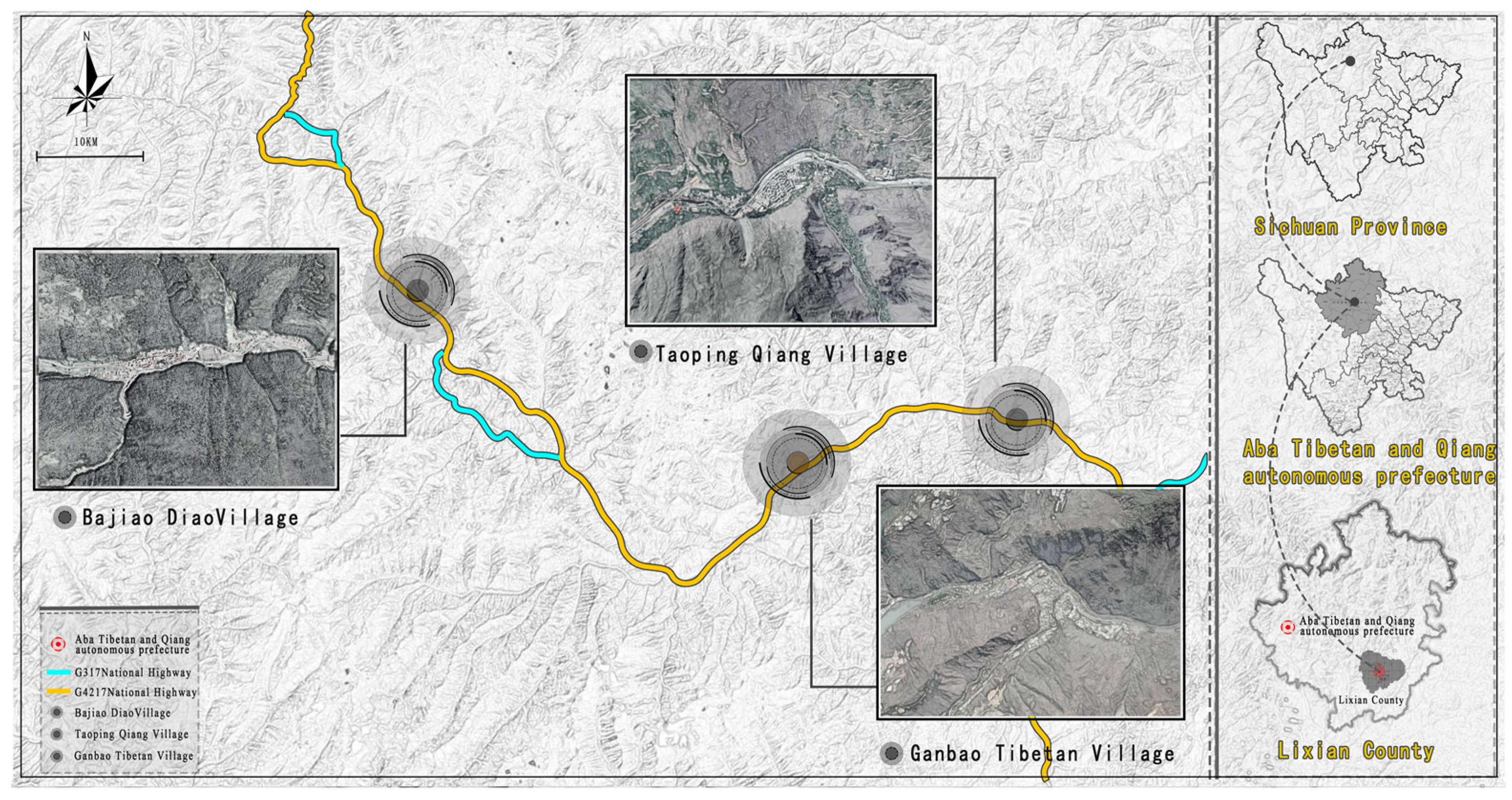
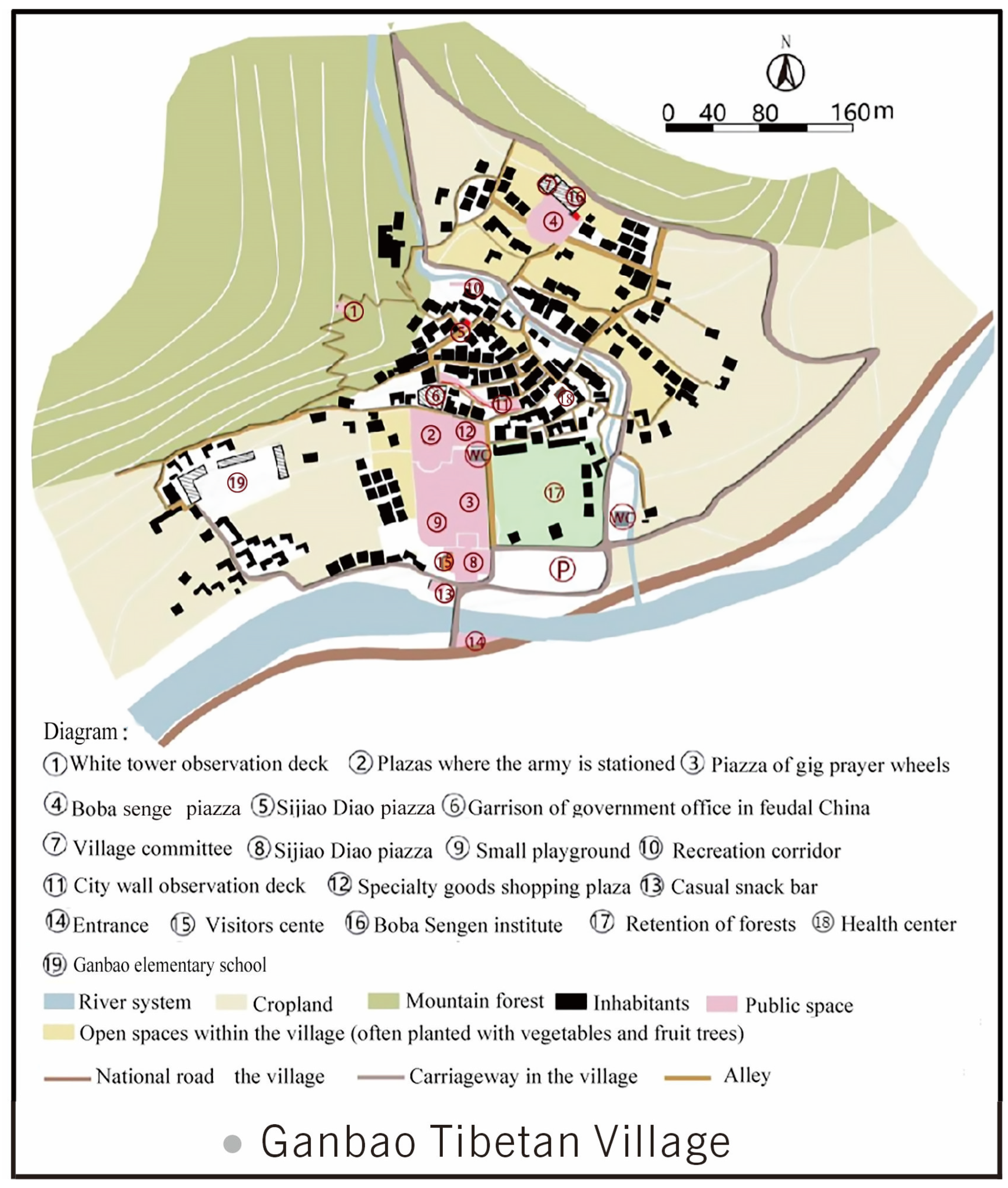
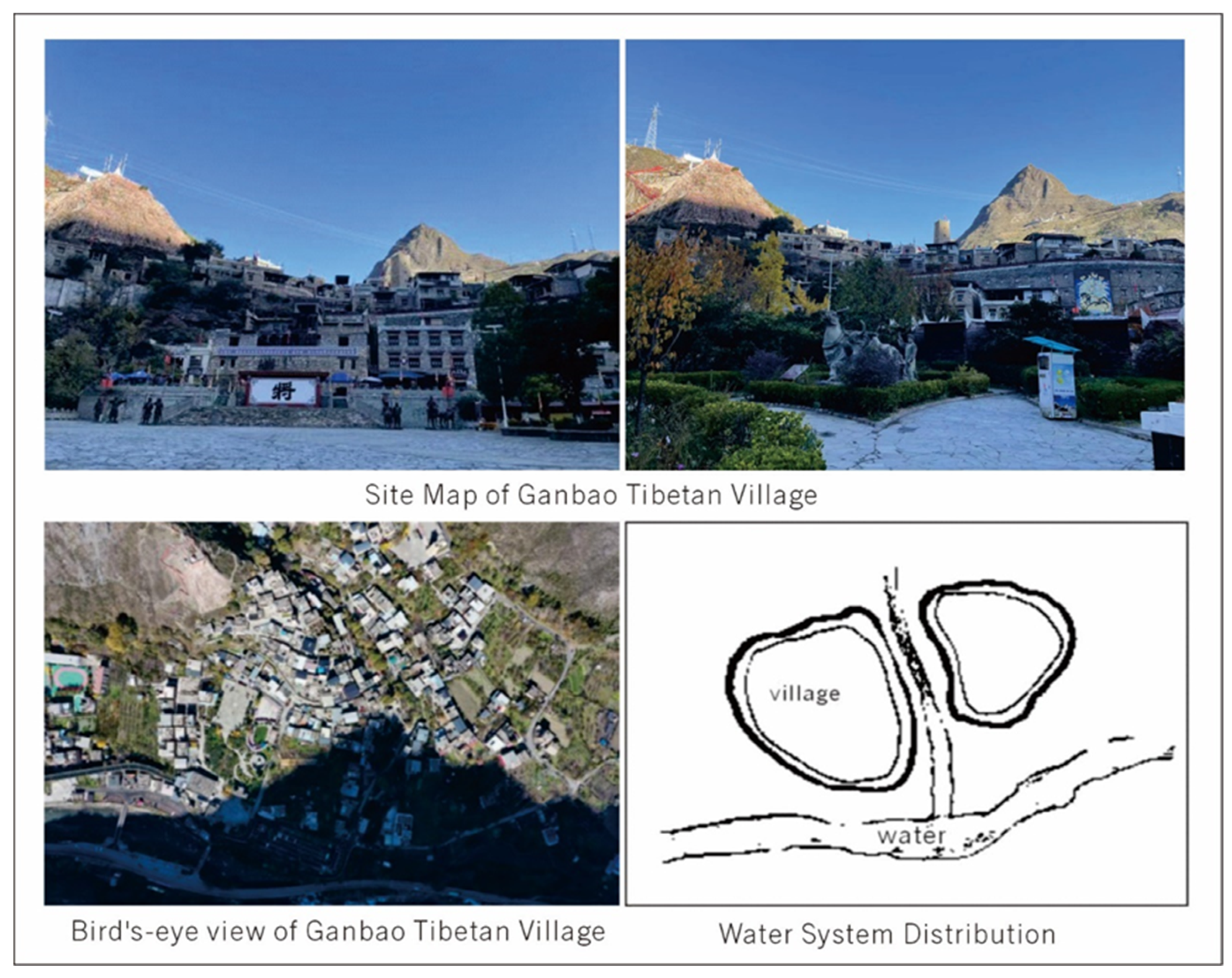


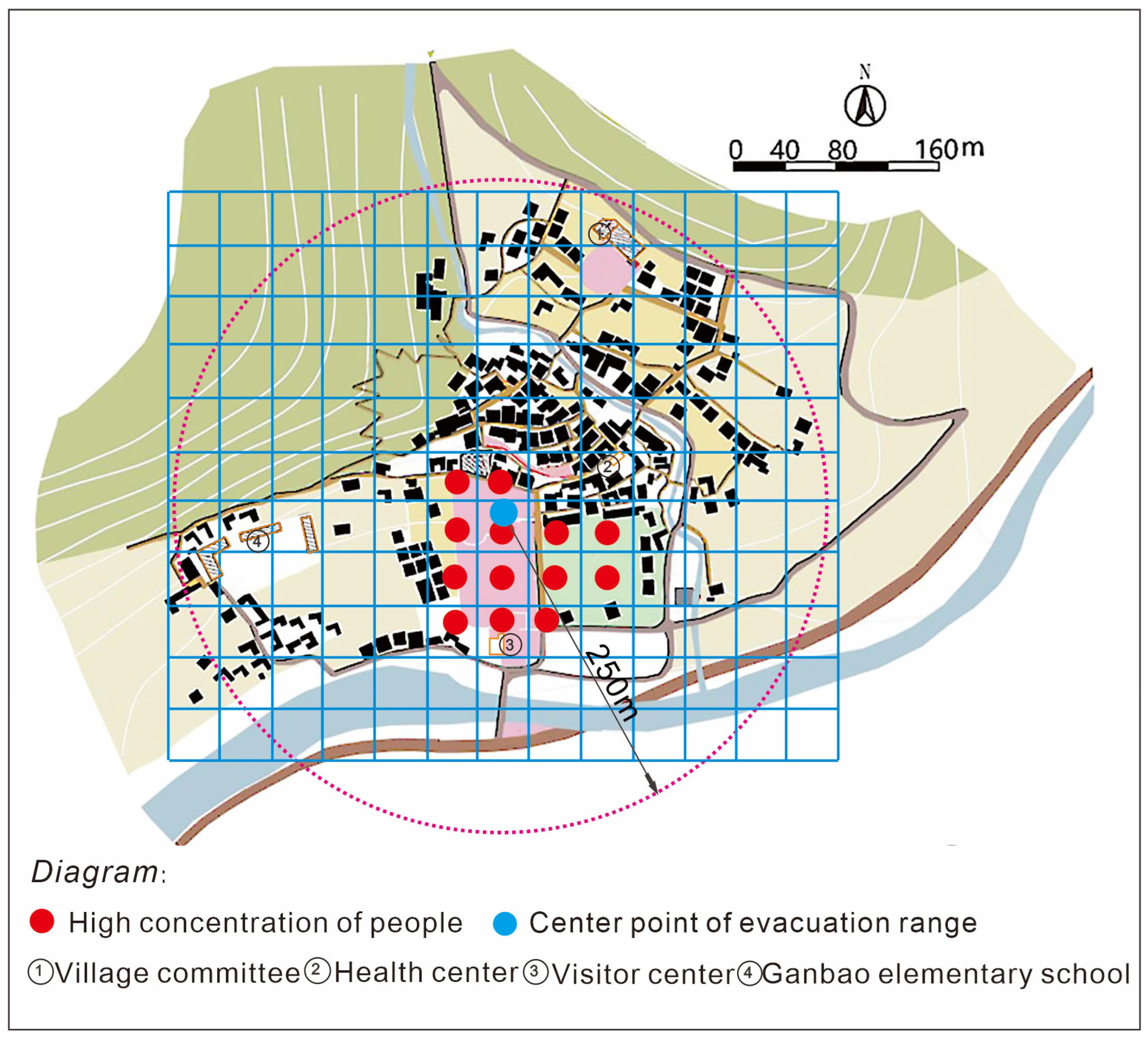
| Standardize | Maximum Opening Hours for Sheltering Design | Minimum Area per Capita | Area of Sheltering Buildings |
|---|---|---|---|
| GB51143-2015 Code for Design of Disasters Mitigation Emergency Congregate Shelter [32] | Emergency sheltering 1 day; temporary sheltering 3 days; medium-term sheltering 15 days; long-term sheltering 100 days | Effective sheltering area per capita for different sheltering periods: emergency, 0.5 m2; temporary, 1.0 m2; short-term, 2.0 m2; medium-term, 3.0 m2; long-term, 4.5 m2. | The total area of the public activity room should not be less than 200 m2; the area of the emergency medical and health center should not be less than 40 m2; the area of the room for emergency management and distribution of emergency materials should not be less than 40 m2. |
| Category | Foldable Bed Length (mm) | Foldable Bed Width (mm) | Single-Side Corridor Width (m) | Evacuation Passage Width (m) |
|---|---|---|---|---|
| Dimensions | 1850 | 700 | ≥0.80 | ≥1.00 |
| Content | Measured Area (m2) | Number of Floors | Area of Each Floor (m2) | Structural Type | ||
|---|---|---|---|---|---|---|
| Basic Information | 523.70 | 3 | First Floor Area: 243.18 | Second Floor Area: 168.30 | Third Floor Area: 112.22 | Brick-Concrete Structure |
| Current Situation | Composition of Functional Spaces in the Building | Dimensions of Composing Spaces (m) | Plan Type | |||
| Hall, Offices, Dressing Room | Interior Space Size Range | Corridor Width | “L-shaped” | |||
| Length: 4.20–10.30 Width: 3.45–6.20 | Width 1: 3.10 Width 2: 1.50 | |||||
| Floor Plan | ||||||
| First Floor Plan | Second Floor Plan | Third Floor Plan | ||||
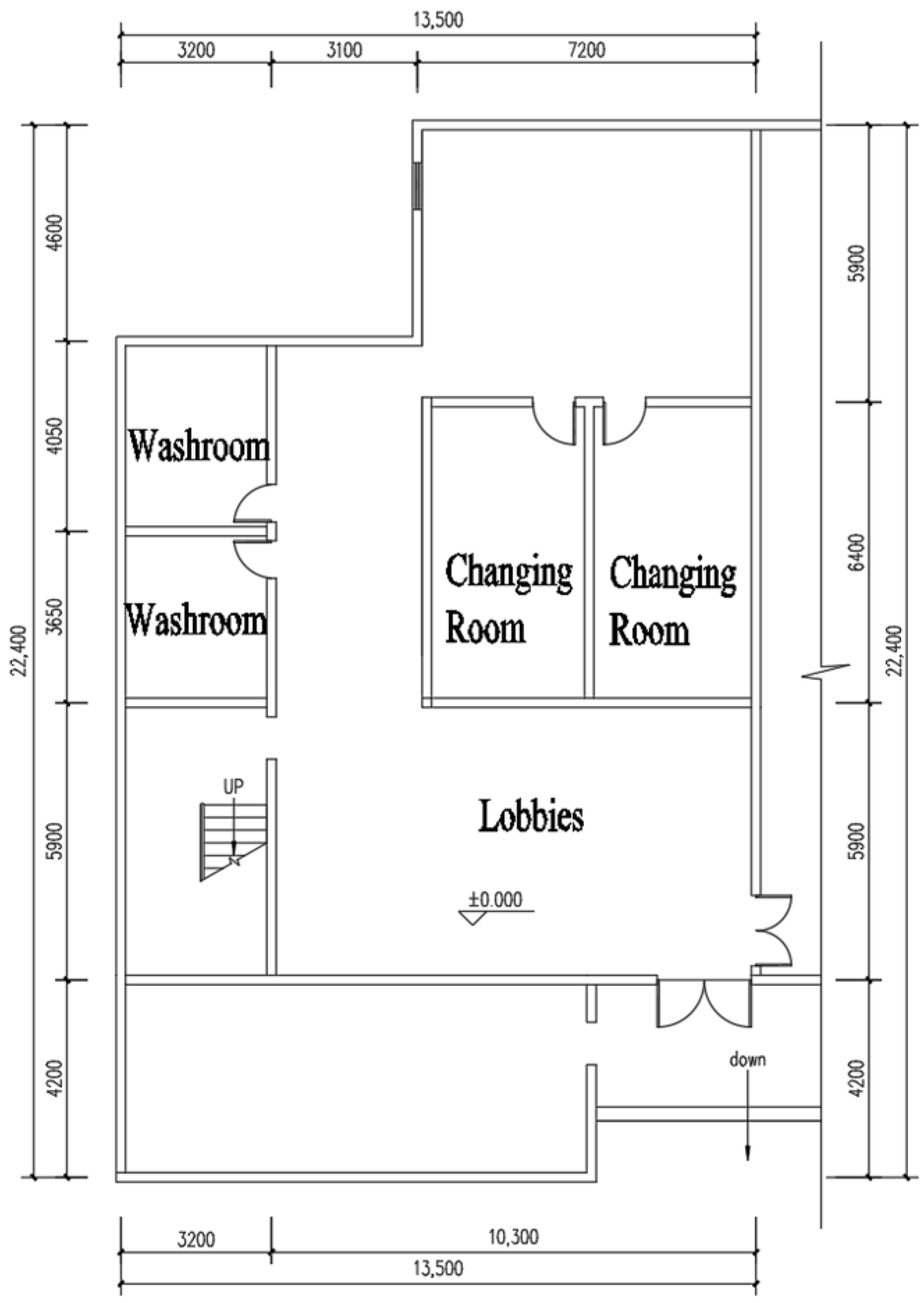 | 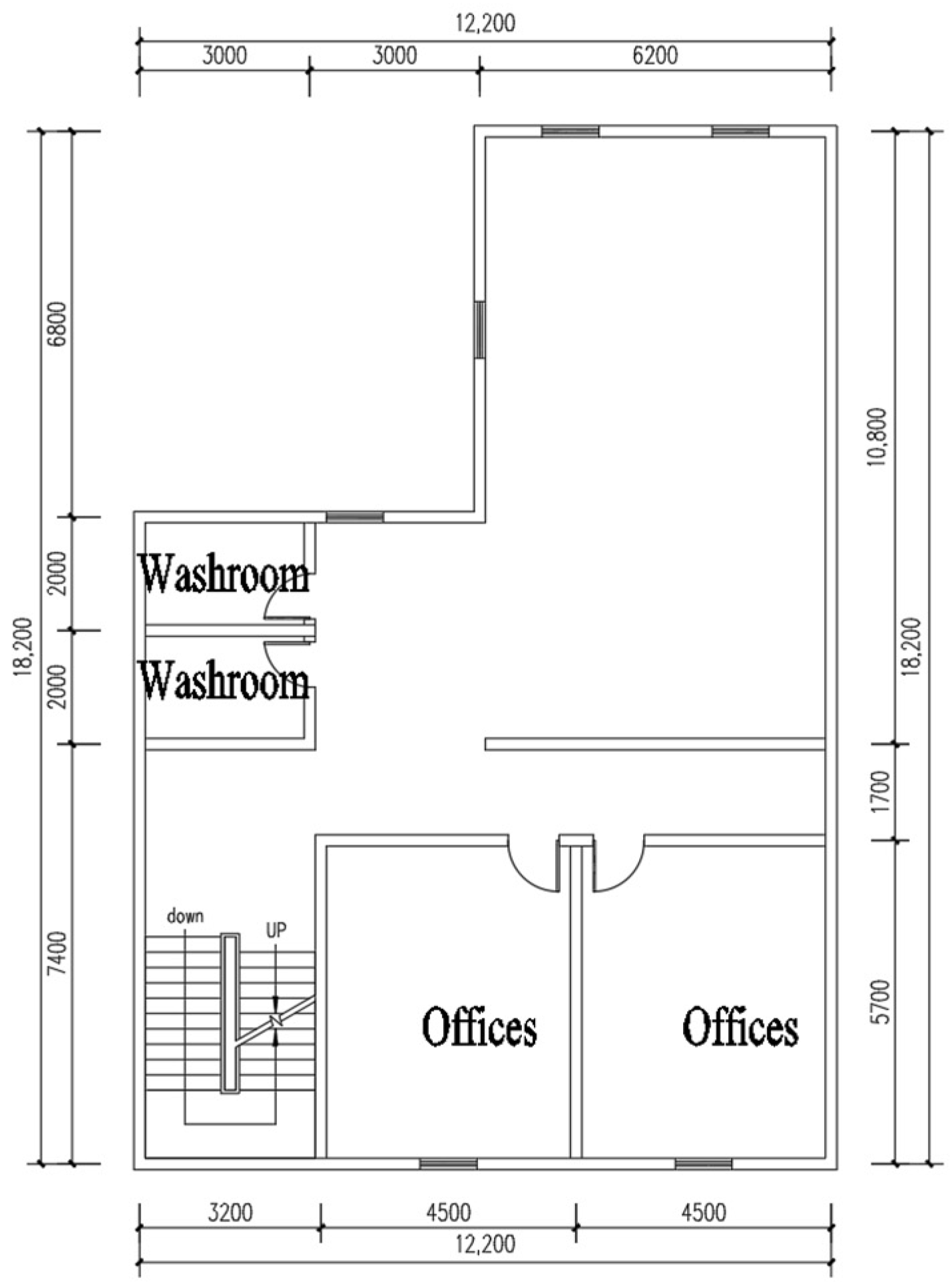 | 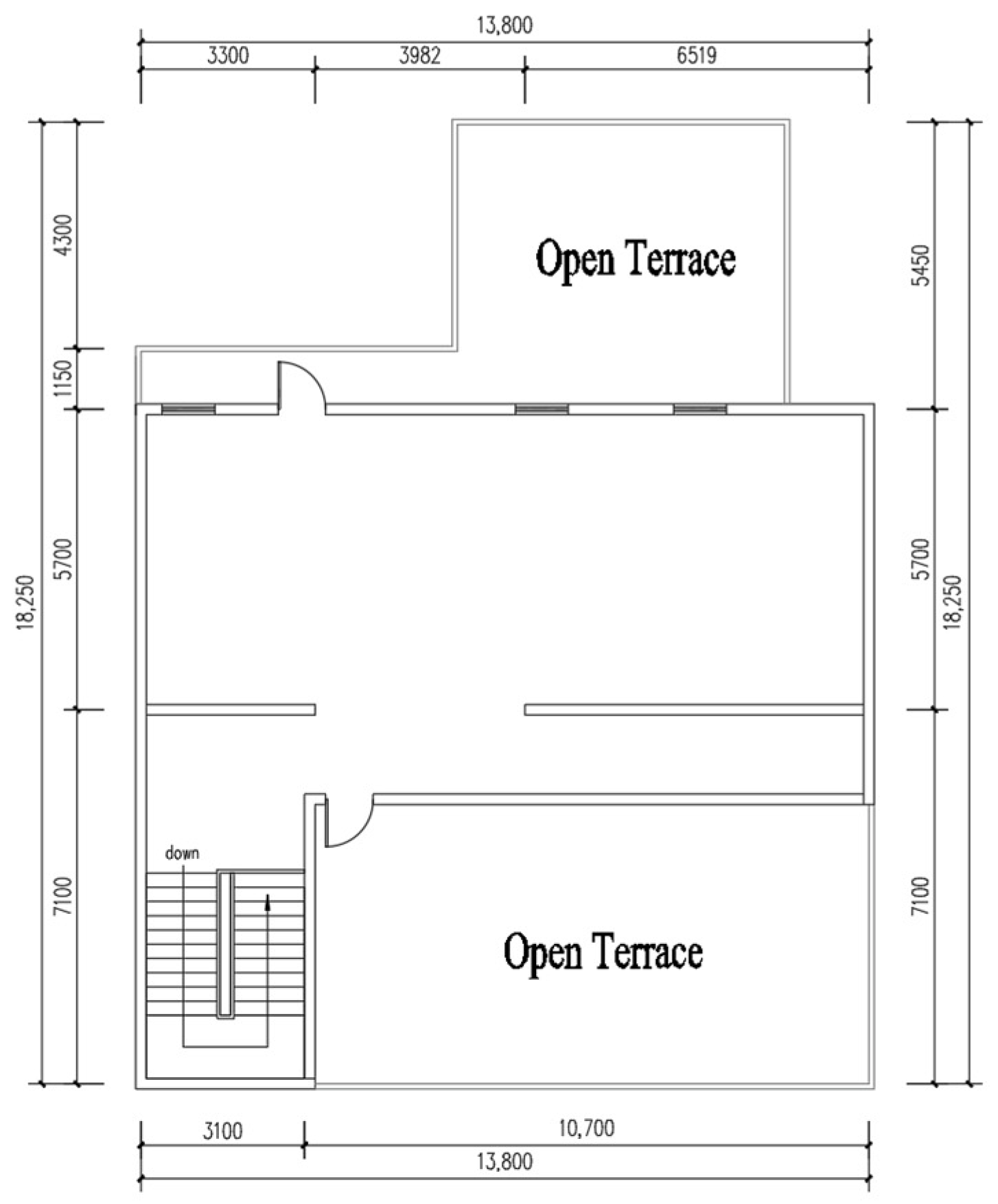 | ||||
| Content | Measured Area (m2) | Number of Floors | Area of Each Floor (m2) | Structural Type | |
|---|---|---|---|---|---|
| Basic Information | 134.90 | 2 | First Floor Area: 75.10 | Second Floor Area: 59.80 | Brick-Concrete Structure |
| Current Situation | Composition of Functional Spaces in the Building | Dimensions of Composing Spaces (m) | Plan Type | ||
| Hall, Office, Consulting Room | Interior Space Size Range | Corridor Width | “I-shaped” | ||
| Length: 4.60–8.00 Width: 3.10–5.80 | Length: 11.00 Width: 1.20 | ||||
| Floor Plan | |||||
| First Floor Plan | Second Floor Plan | ||||
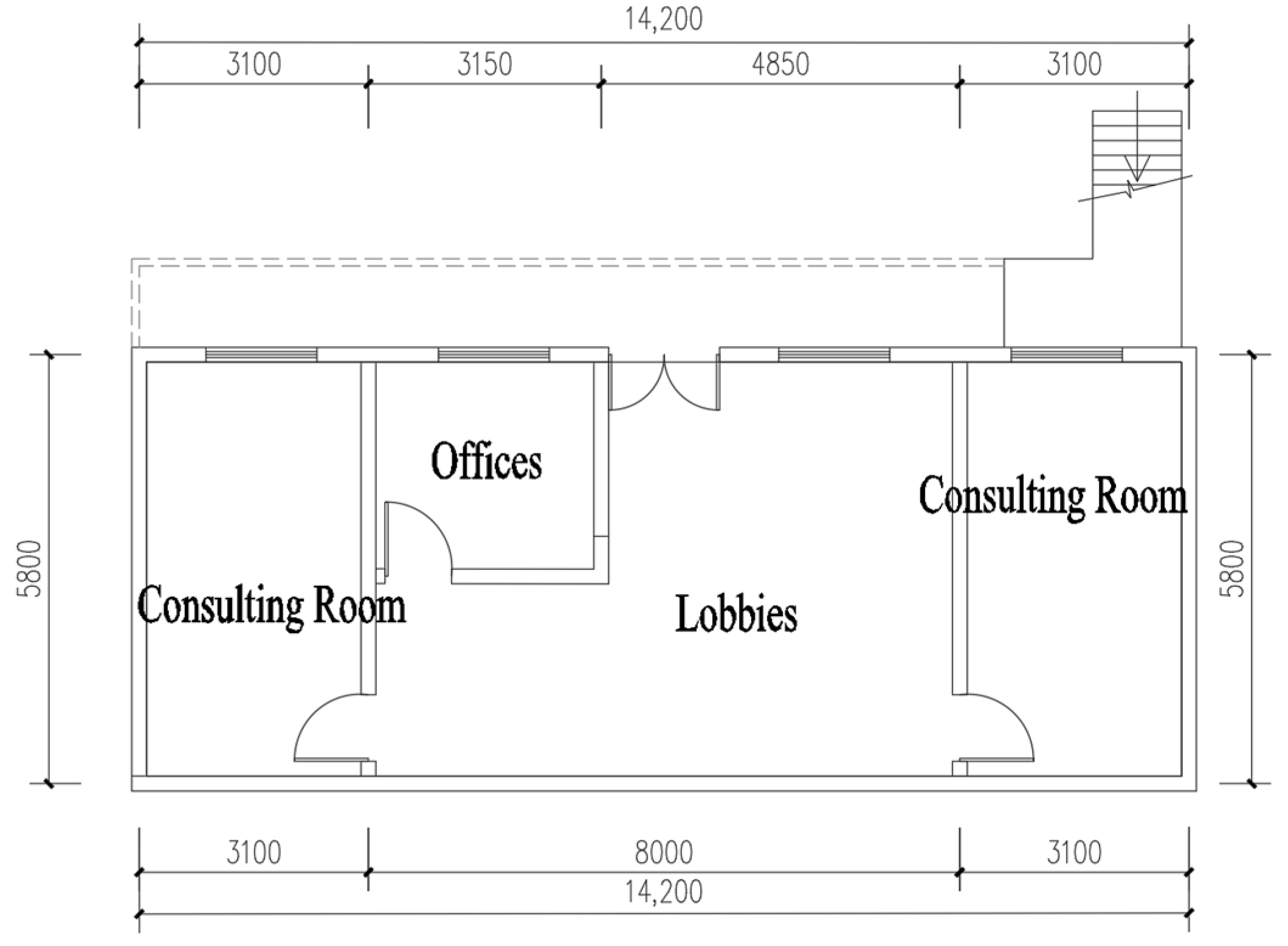 | 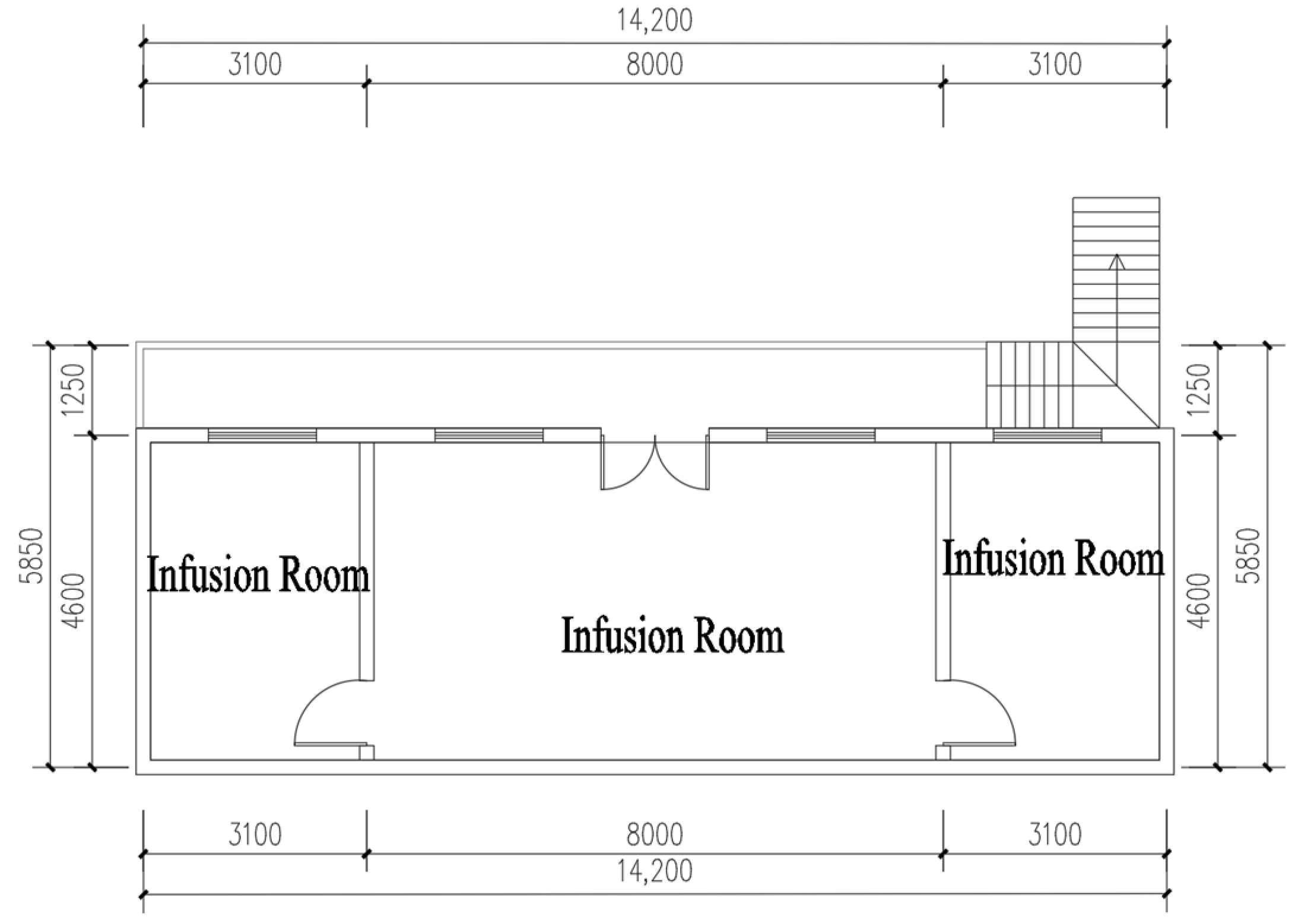 | ||||
| Content | Measured Area (m2) | Number of Floors | Area of Each Floor (m2) | Structural Type | |
|---|---|---|---|---|---|
| Basic Information | 187.90 | 2 | First Floor Area: 137.50 | Second Floor Area: 50.40 | Brick-Concrete Structure |
| Current Situation | Composition of Functional Spaces in the Building | Interior Space Size Range (m) | Plan Type | ||
| Hall, Exhibition Hall | Length: 6.80–9.20 Width: 2.70–8.60 | “L-shaped” | |||
| Floor Plan | |||||
| First Floor Plan | Second Floor Plan | ||||
 | 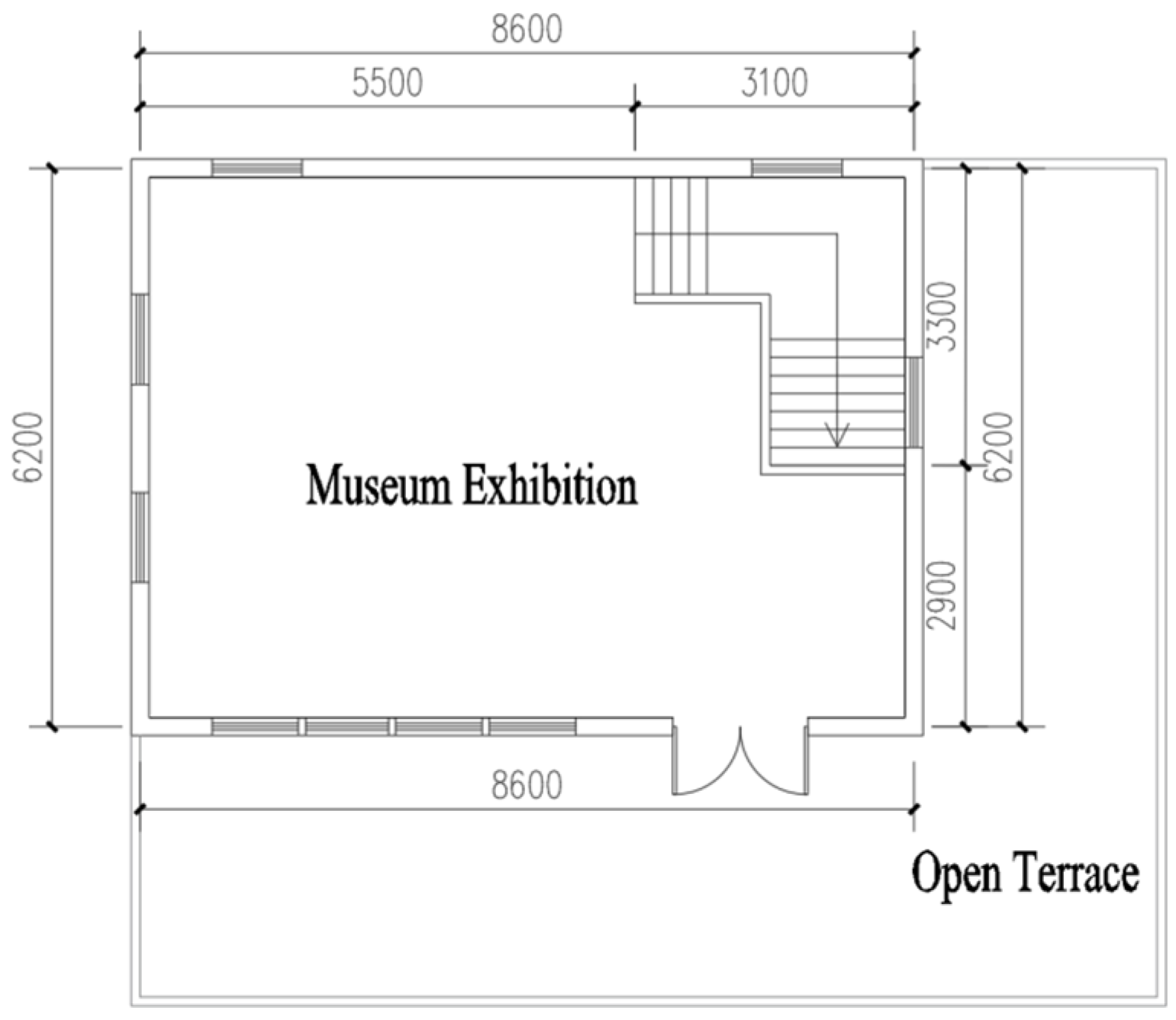 | ||||
| Building Floors | Effective Sheltering Rate (Small Spaces) | |
|---|---|---|
| Emergency Sheltering Effectiveness Rate: 64.90% | Short-Term Sheltering Effectiveness Rate: 62.17% | |
| First Floor Plan Layout | 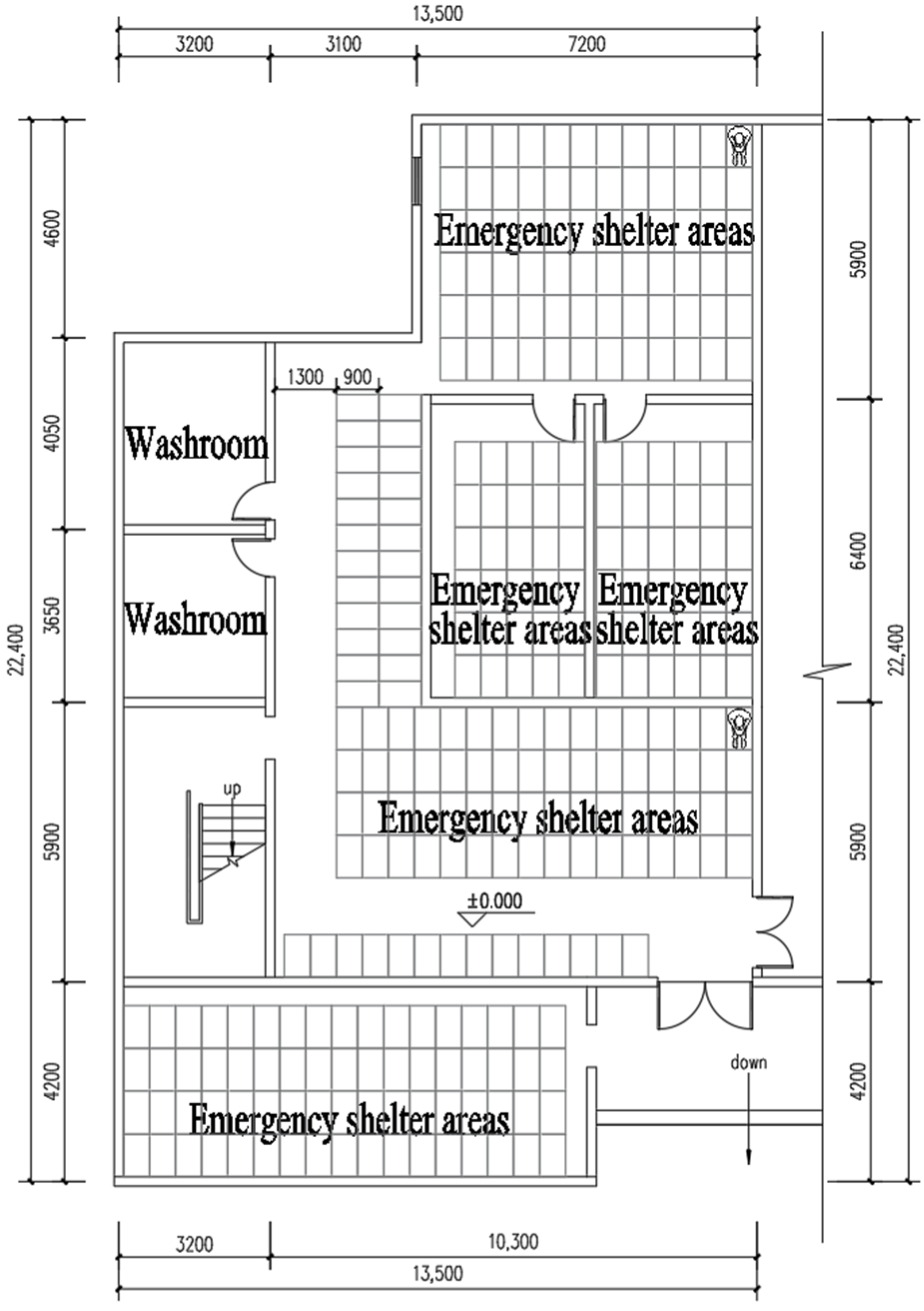 |  |
| Second Floor Plan Layout | 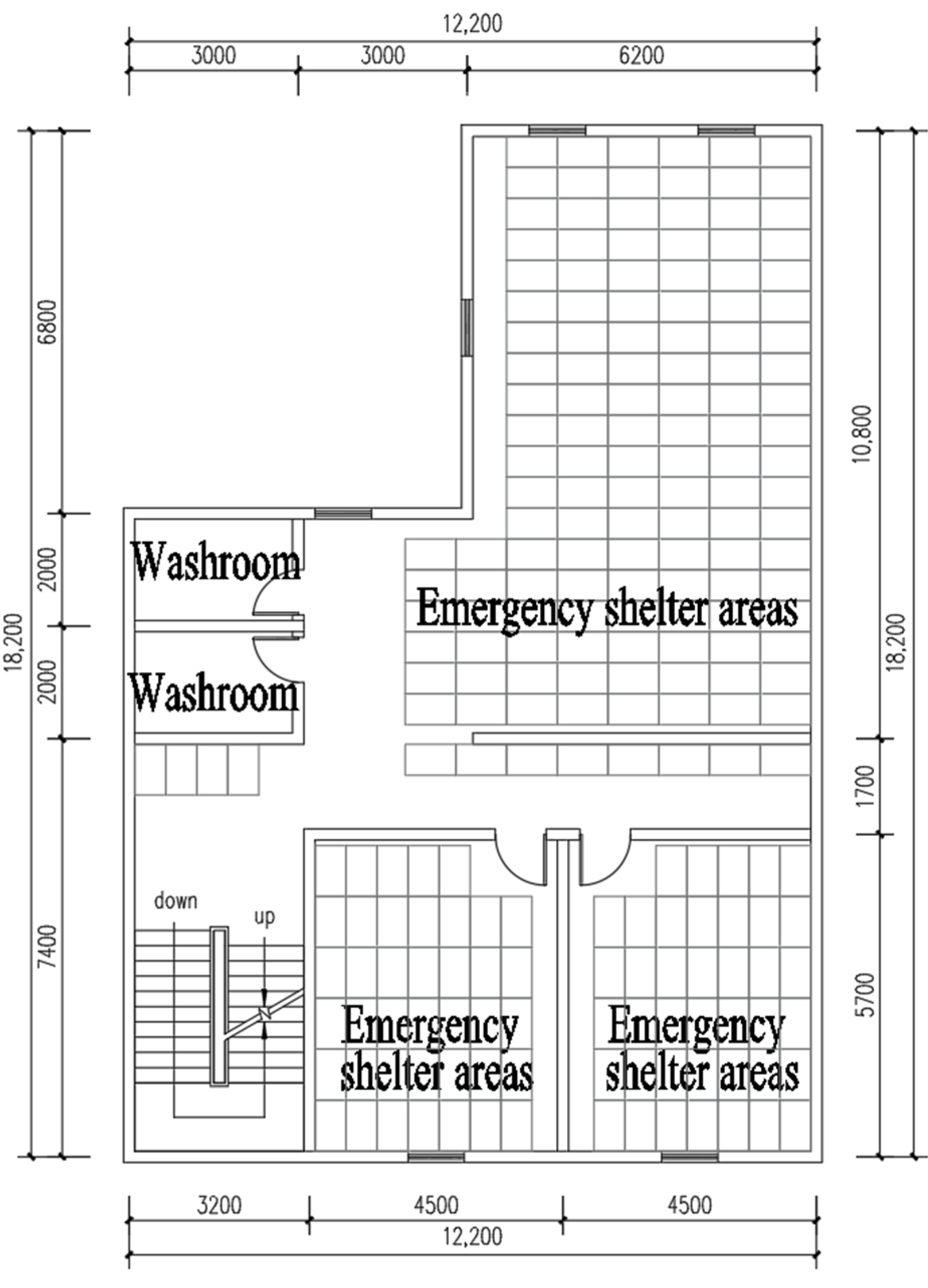 | 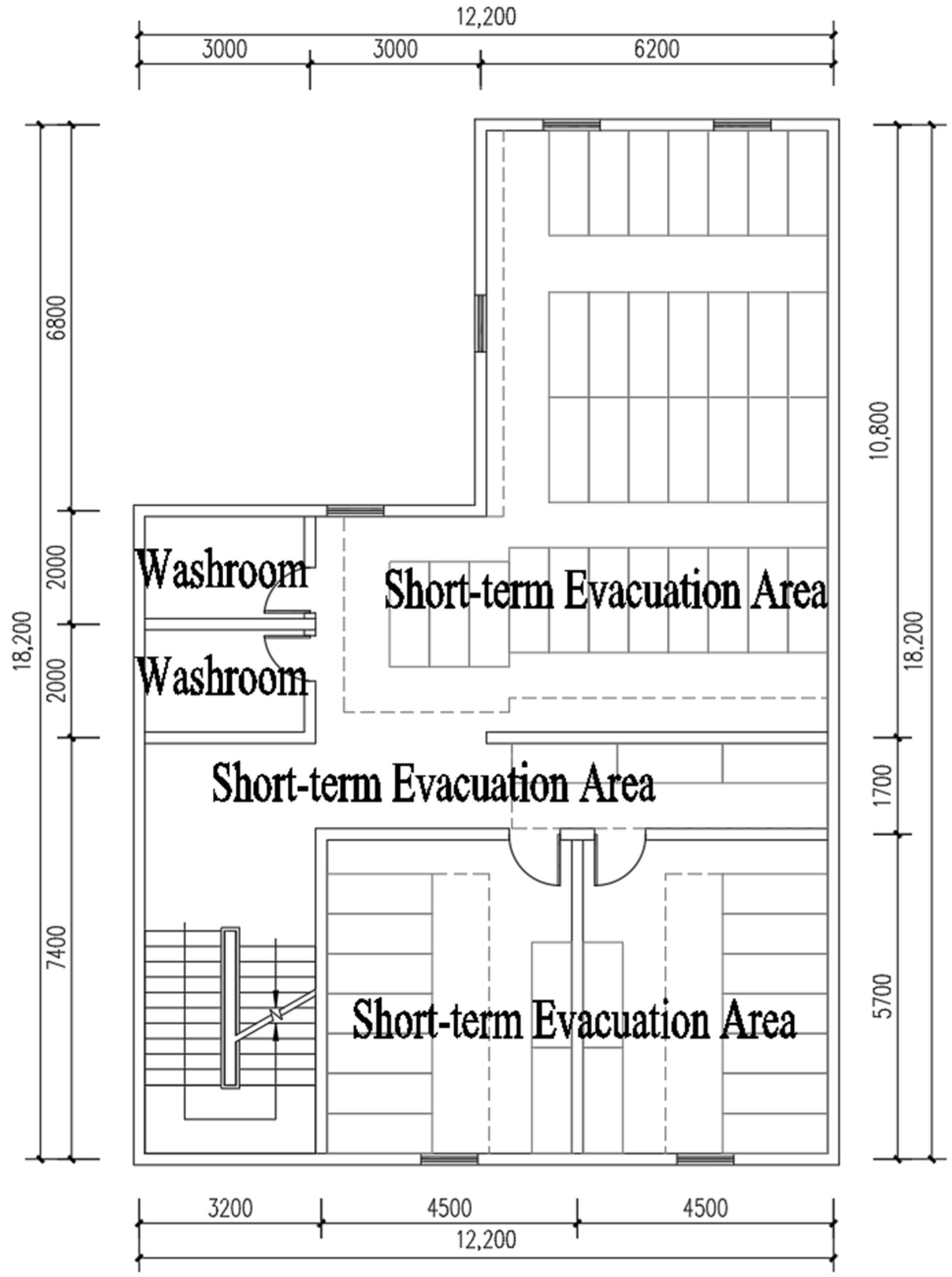 |
| Third Floor Plan Layout | 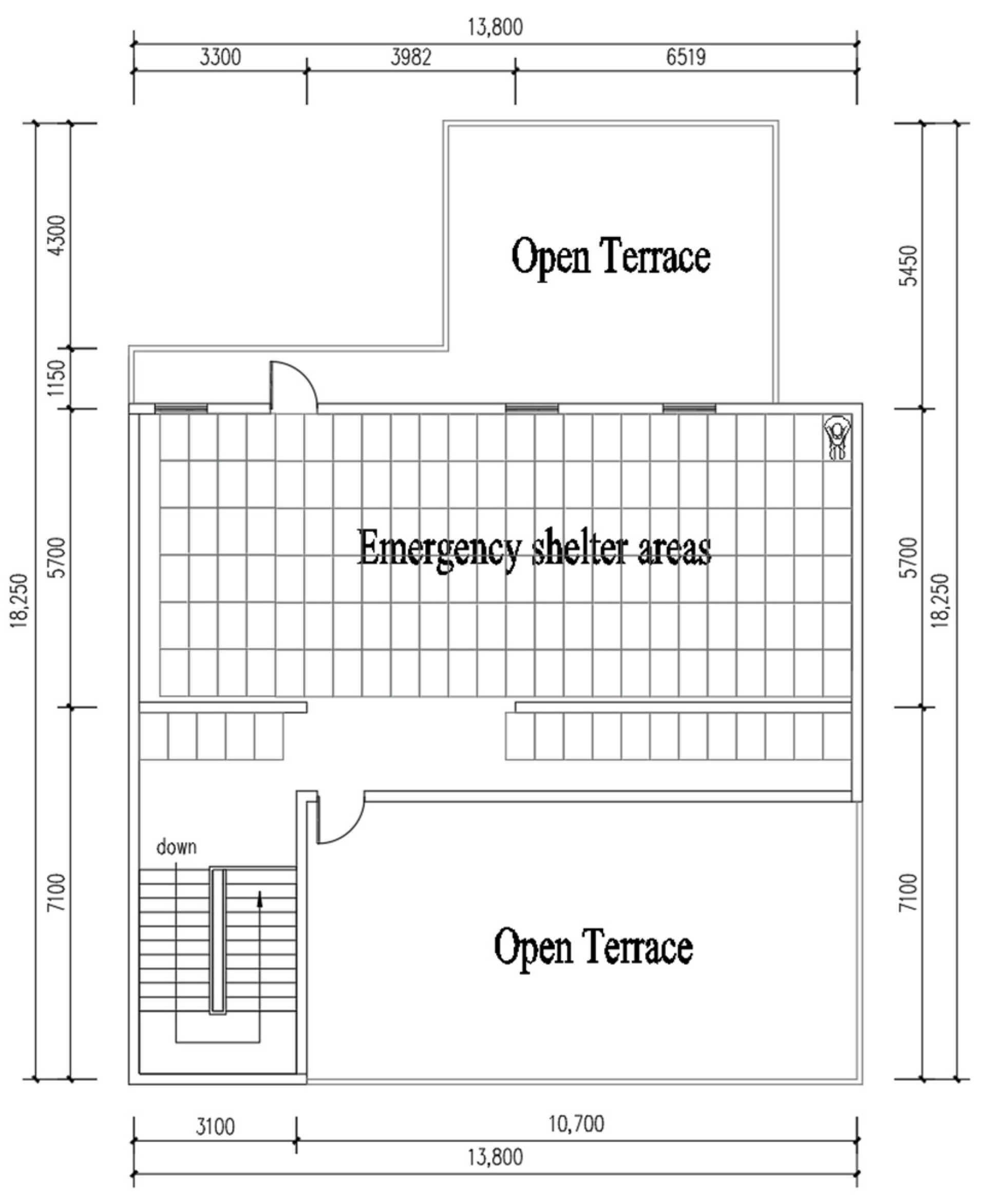 | 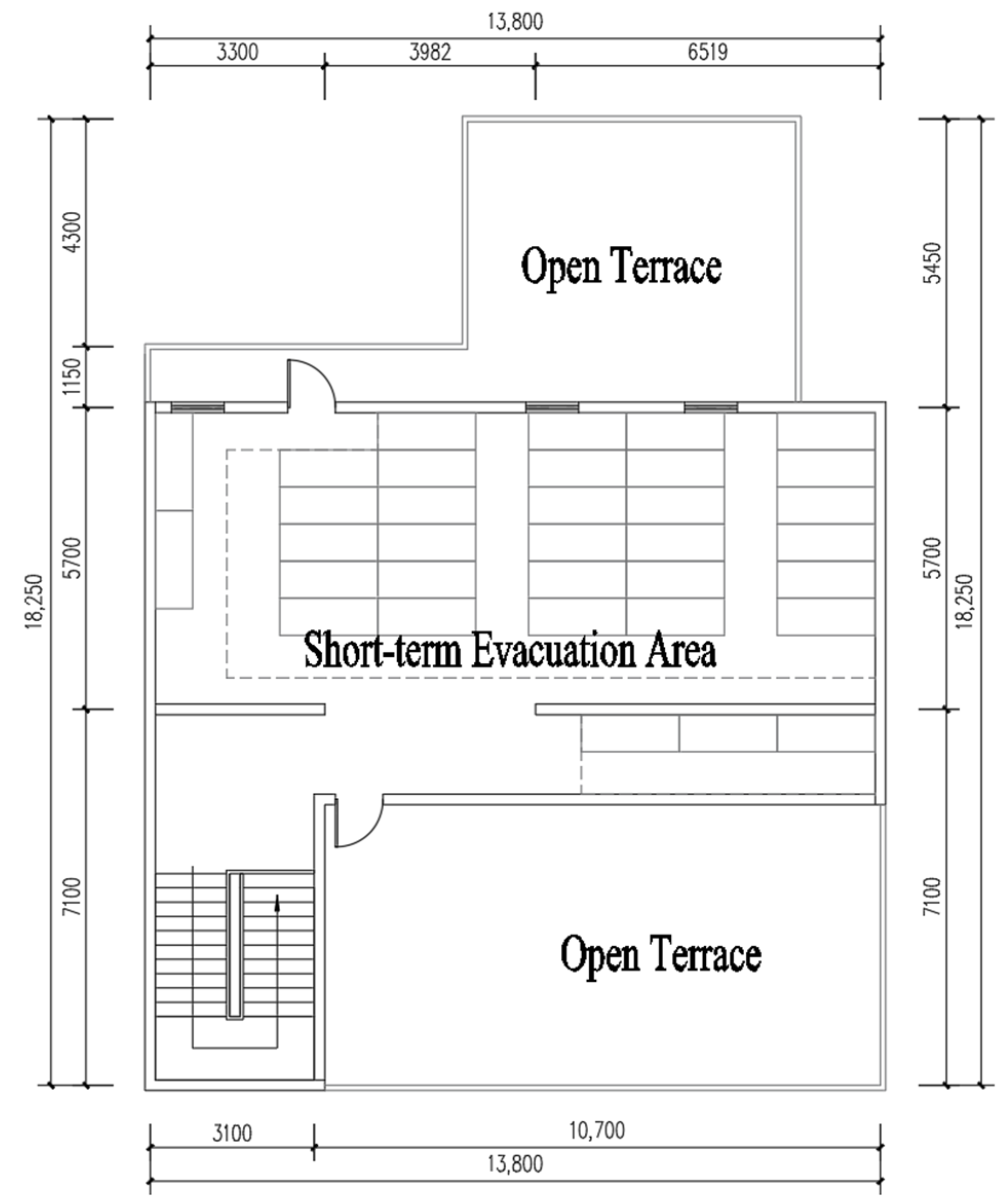 |
| Building Floors | Effective Sheltering Rate (Small Spaces) | |
|---|---|---|
| Emergency Sheltering Effectiveness Rate: 51.20% | Short-Term Sheltering Effectiveness Rate: 56.78% | |
| First Floor Plan Layout | 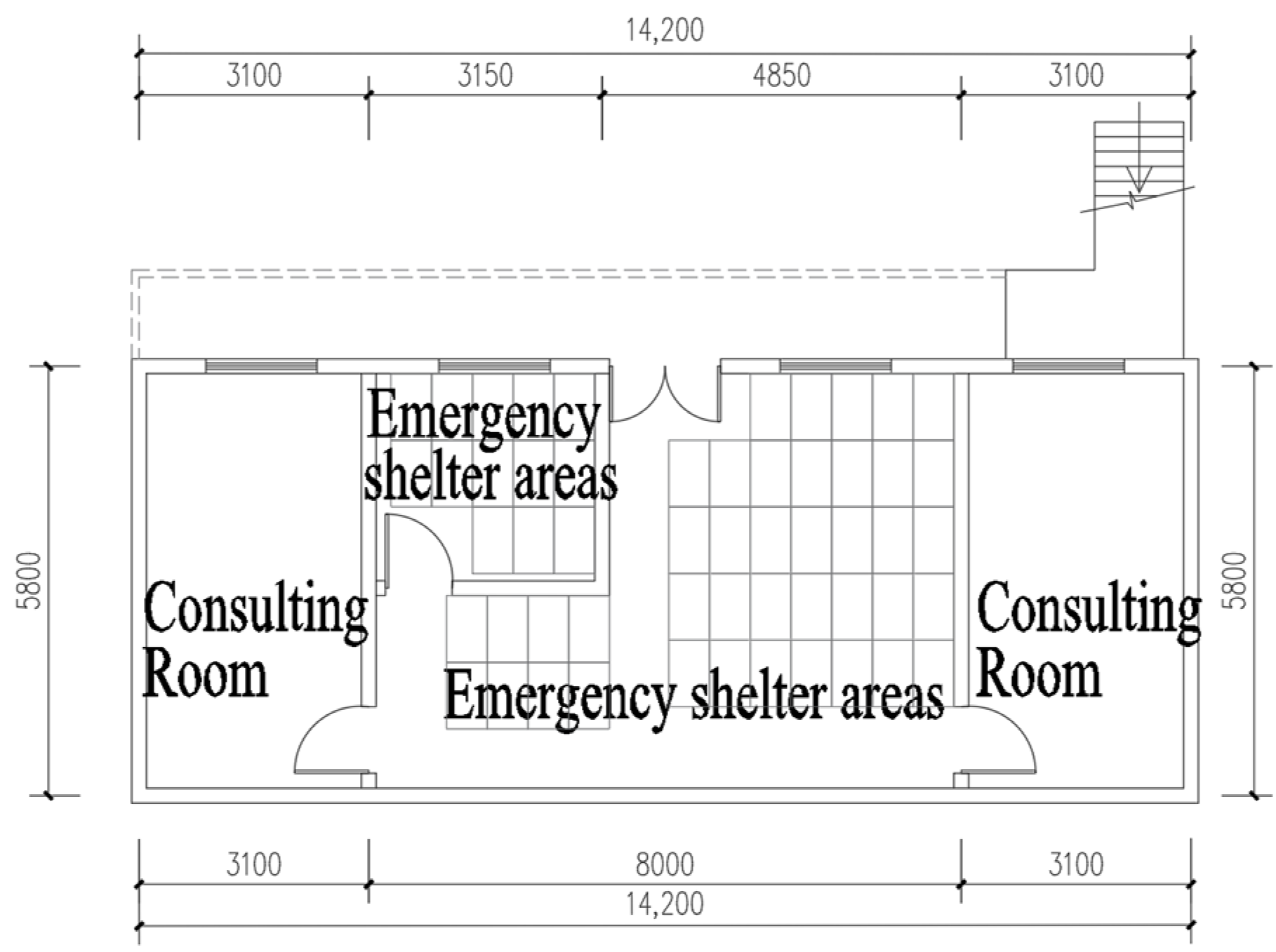 | 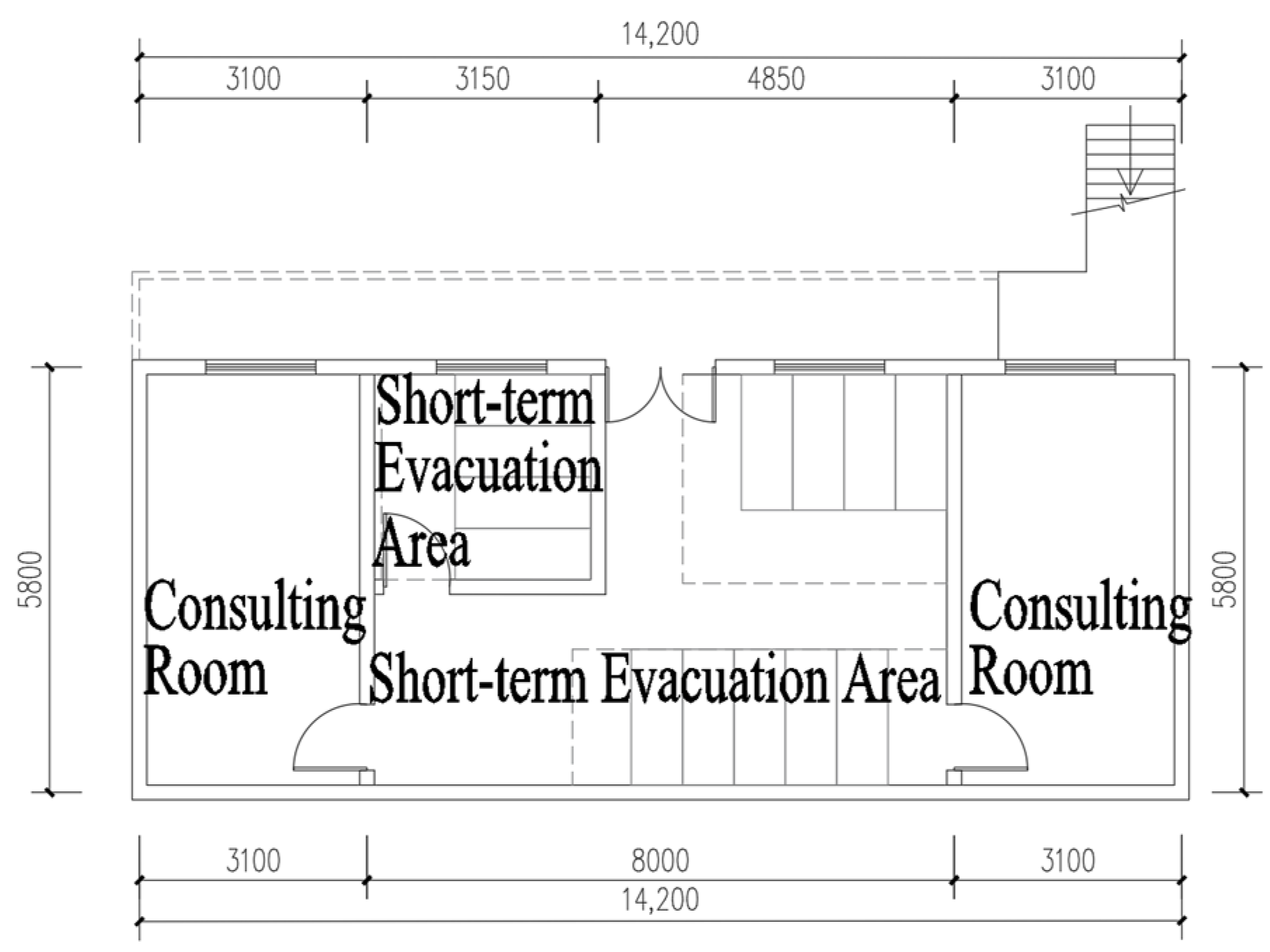 |
| Second Floor Plan Layout | 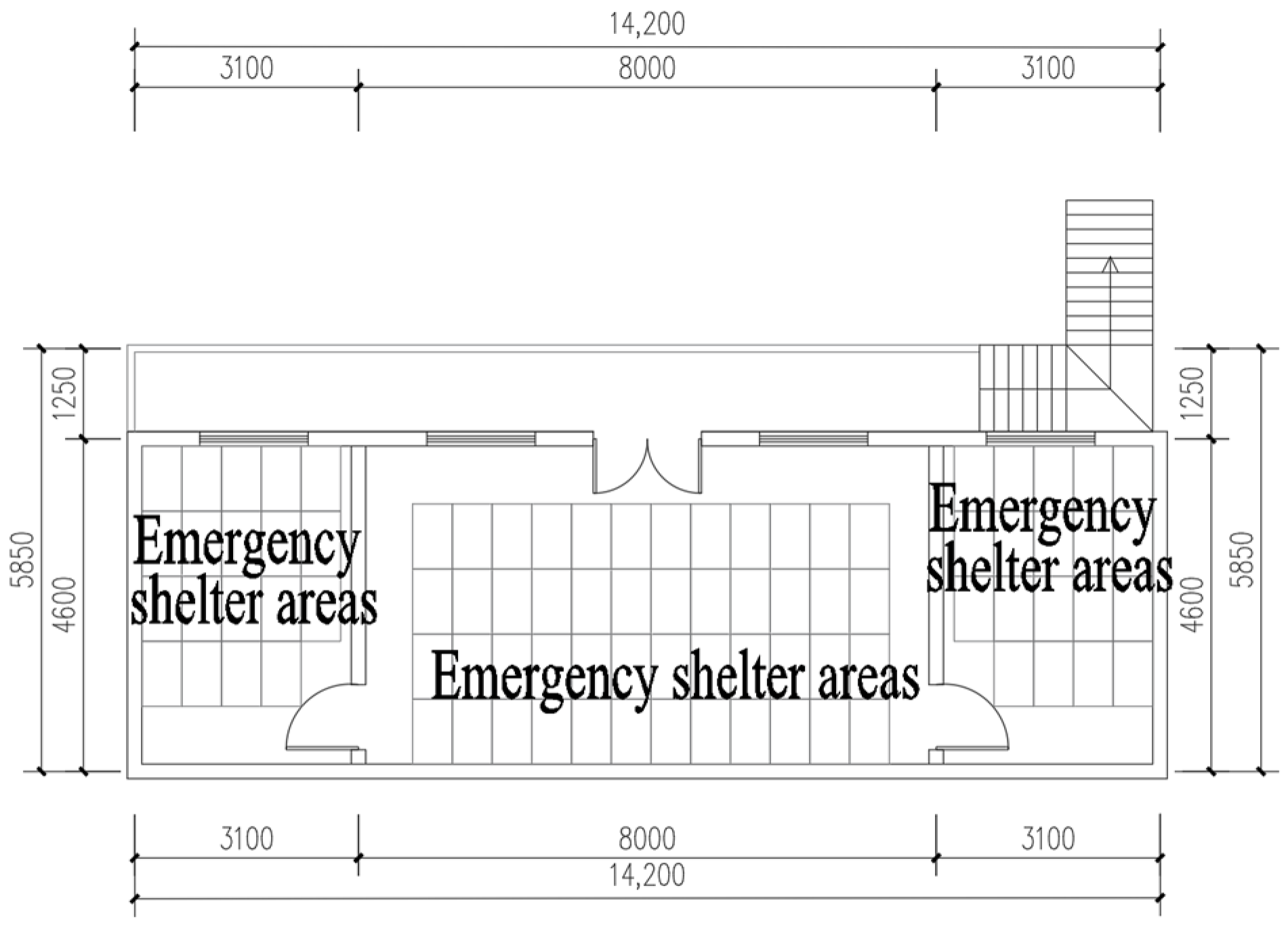 | 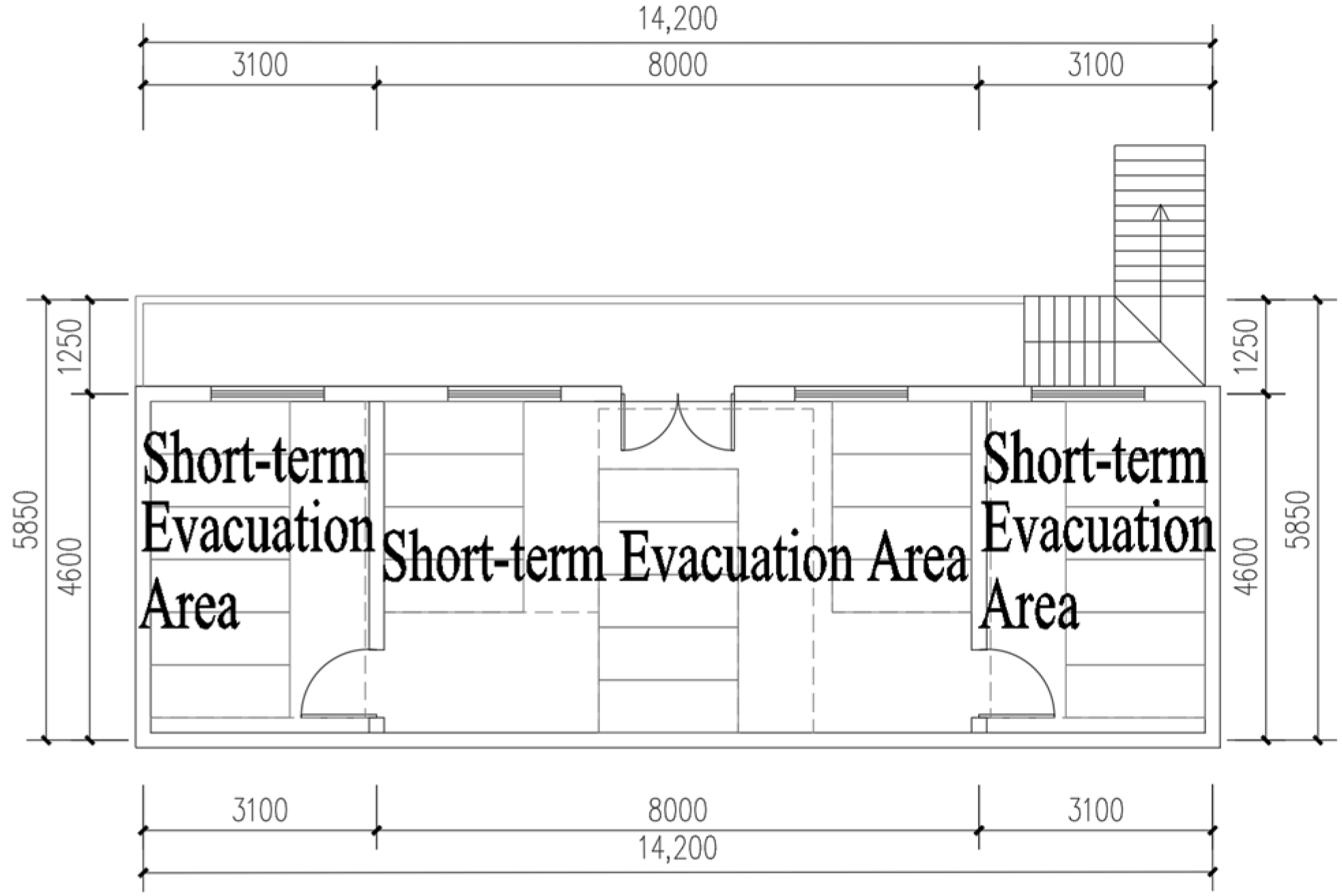 |
| Building Floors | Effective Sheltering Rate (Large Spaces) | |
|---|---|---|
| Emergency Sheltering Effectiveness Rate: 61.91% | Short-Term Sheltering Effectiveness Rate: 54.60% | |
| First Floor Plan Layout | 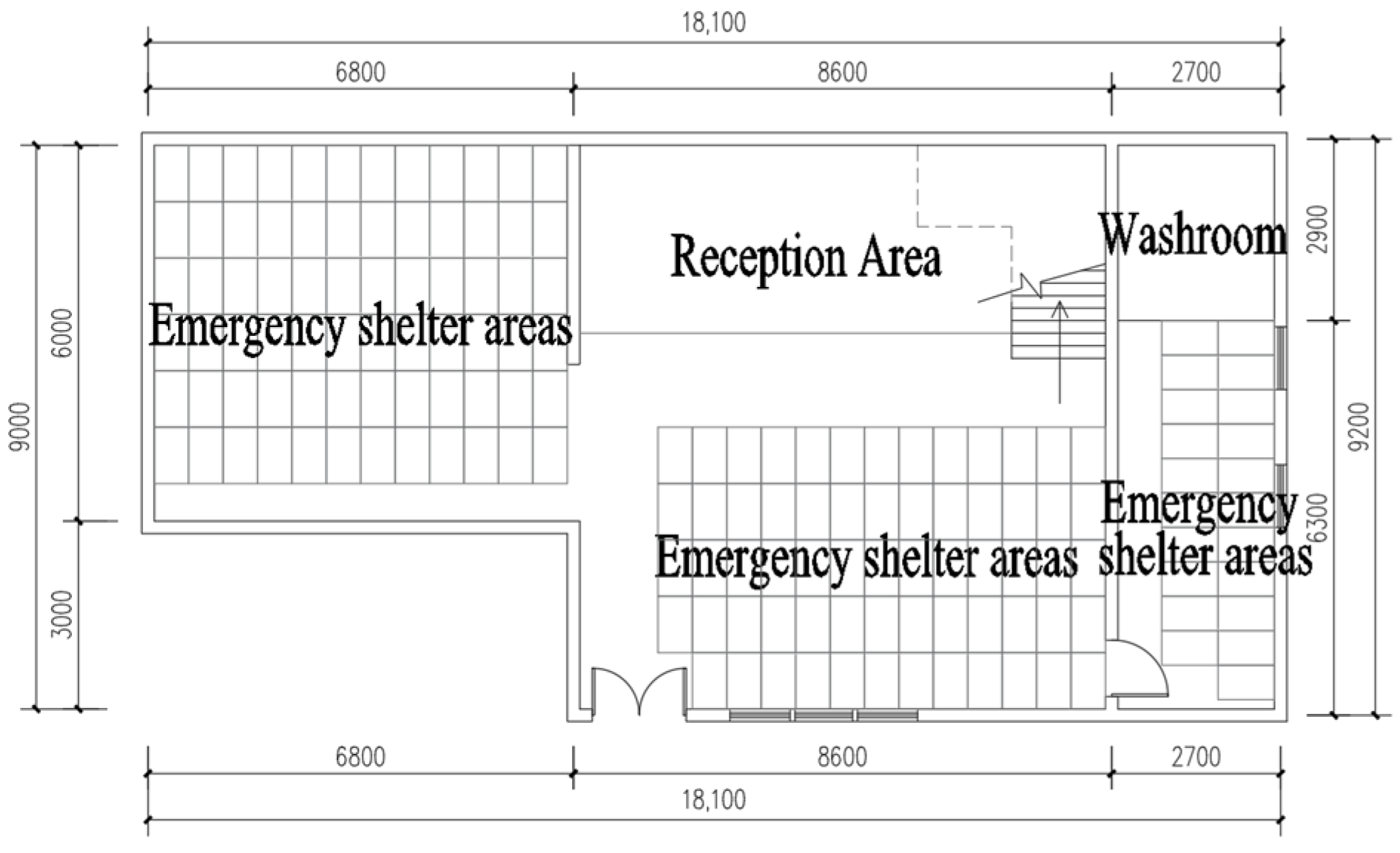 | 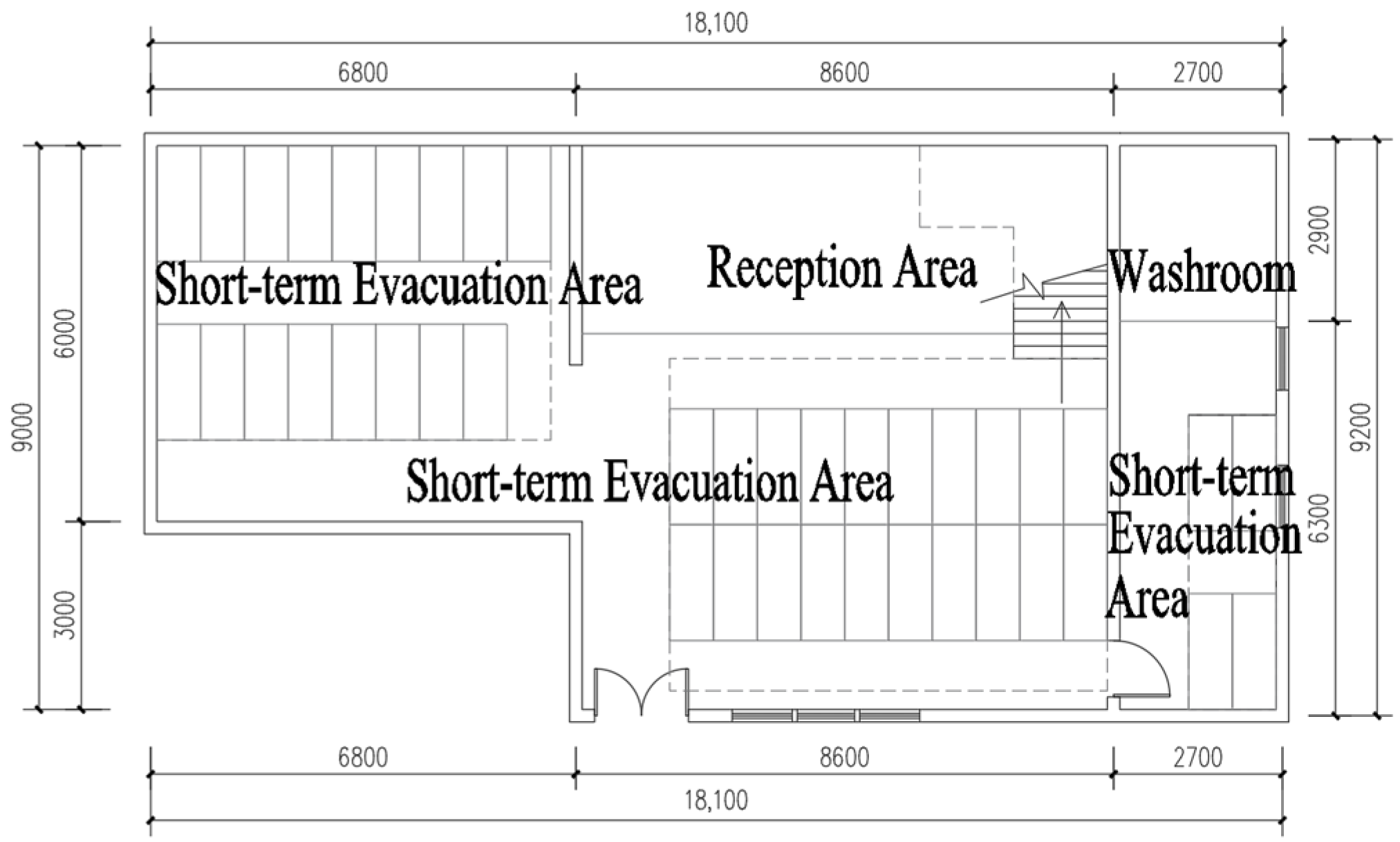 |
| Second Floor Plan Layout | 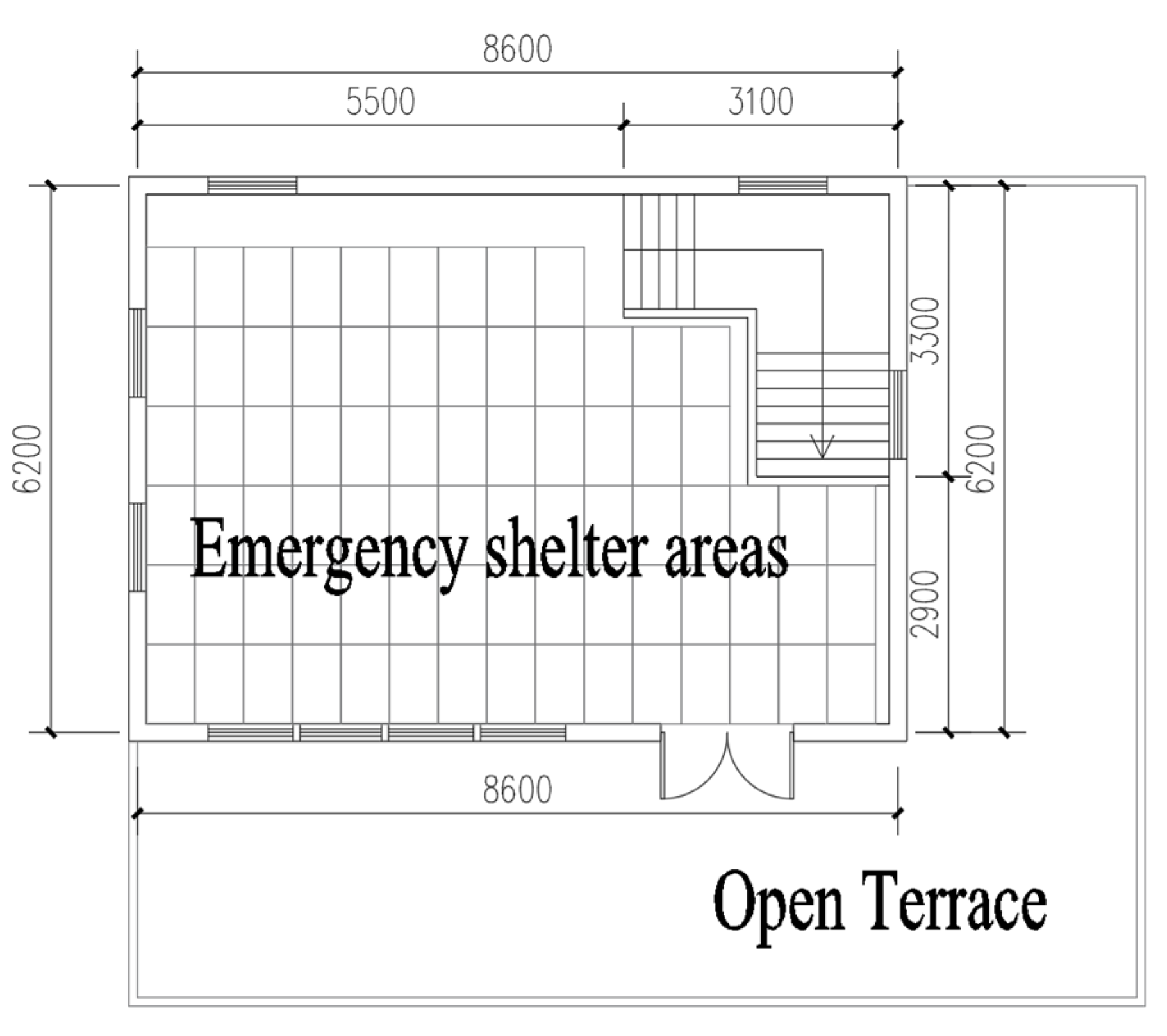 | 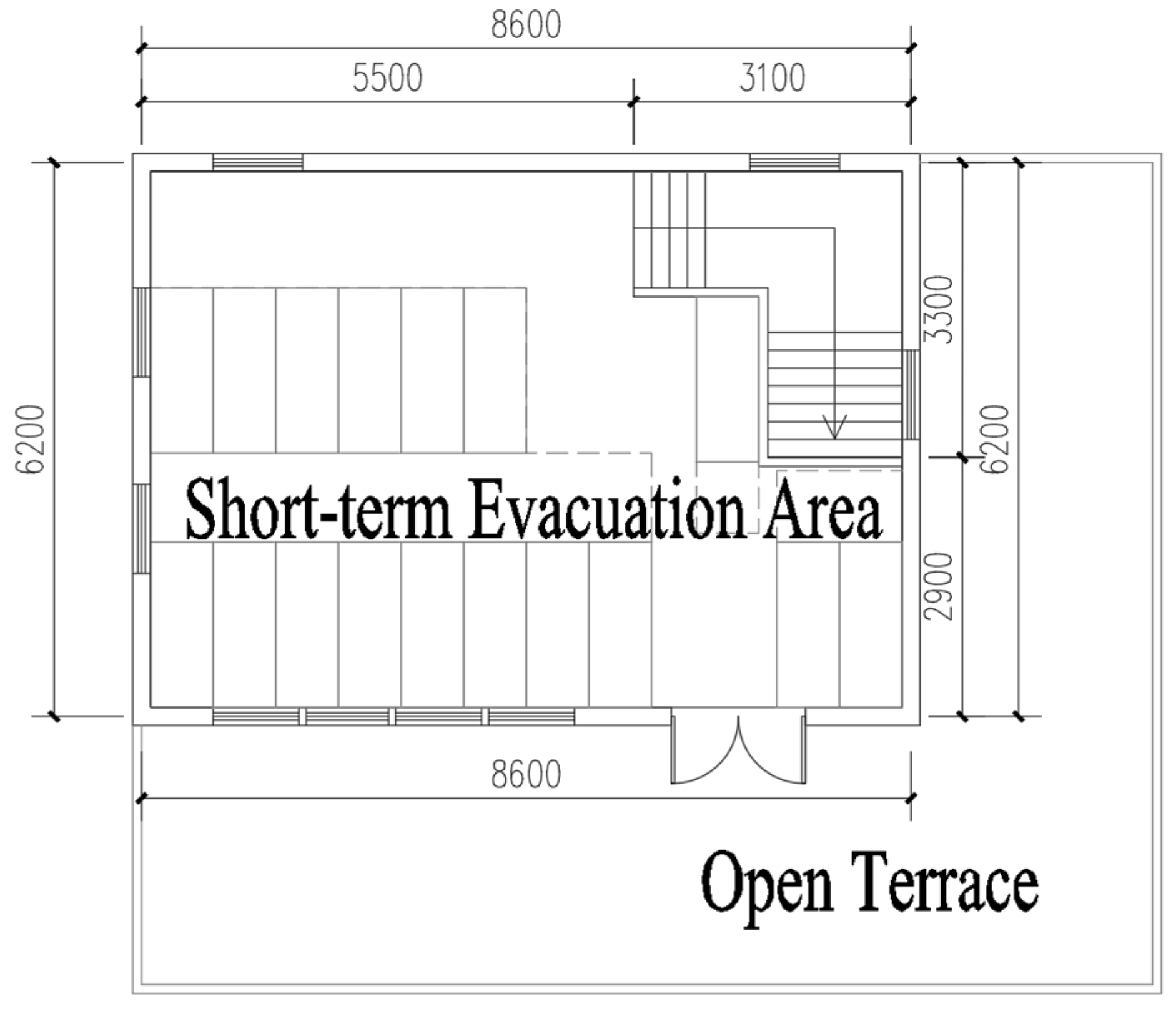 |
| Village Name | Original Length and Width Dimensions (Length: 5.70 m, Width: 4.50 m) | Adjustment Method Two (Length: 5.80 m, Width: 4.90 m) |
|---|---|---|
| Ganbao Tibetan Village (Village Committee) |  | 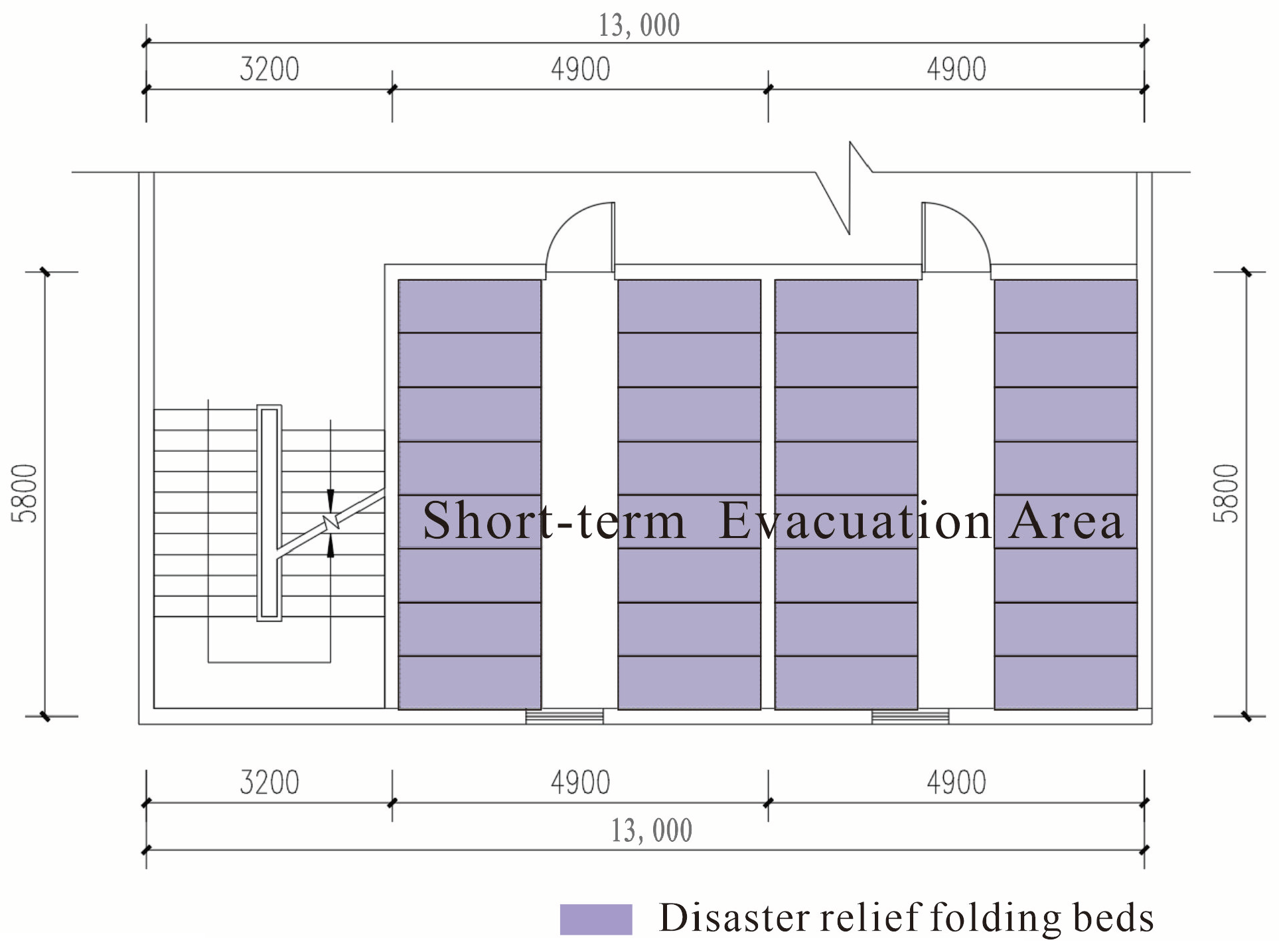 |
| Effective Shelter Area Zone | 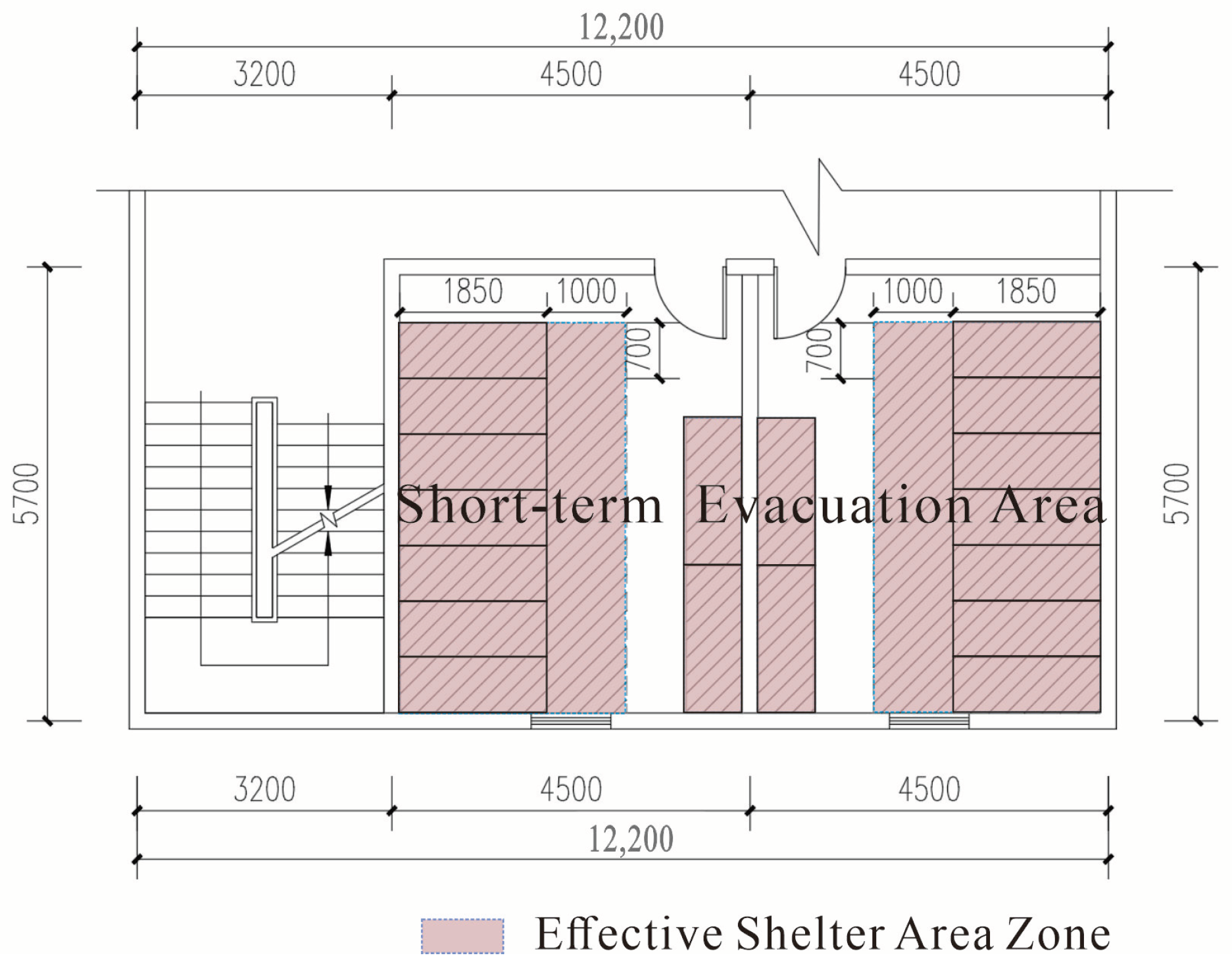 | 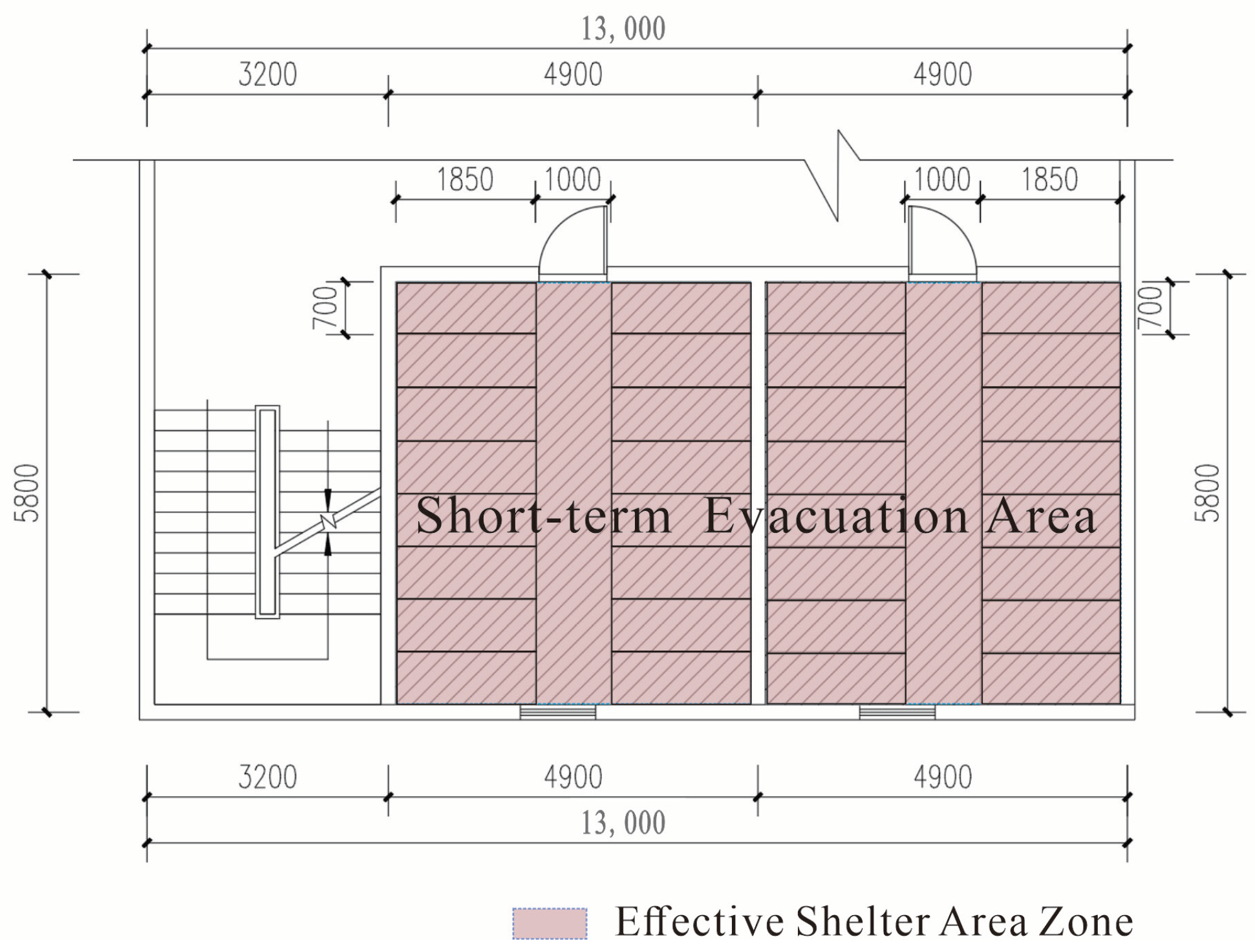 |
| Effective Sheltering Rates | Highest Effective Sheltering Rate: 69.90% | Effective Sheltering Rate (Outward Opening Doors): 100% |
| Category | Original Length and Width Dimensions (Length: 4.60 m Width: 3.21 m) | Adjusting Dimensions and Door Opening Direction (Length: 4.40 m Width: 3.15 m) |
|---|---|---|
| Pattern 1 | 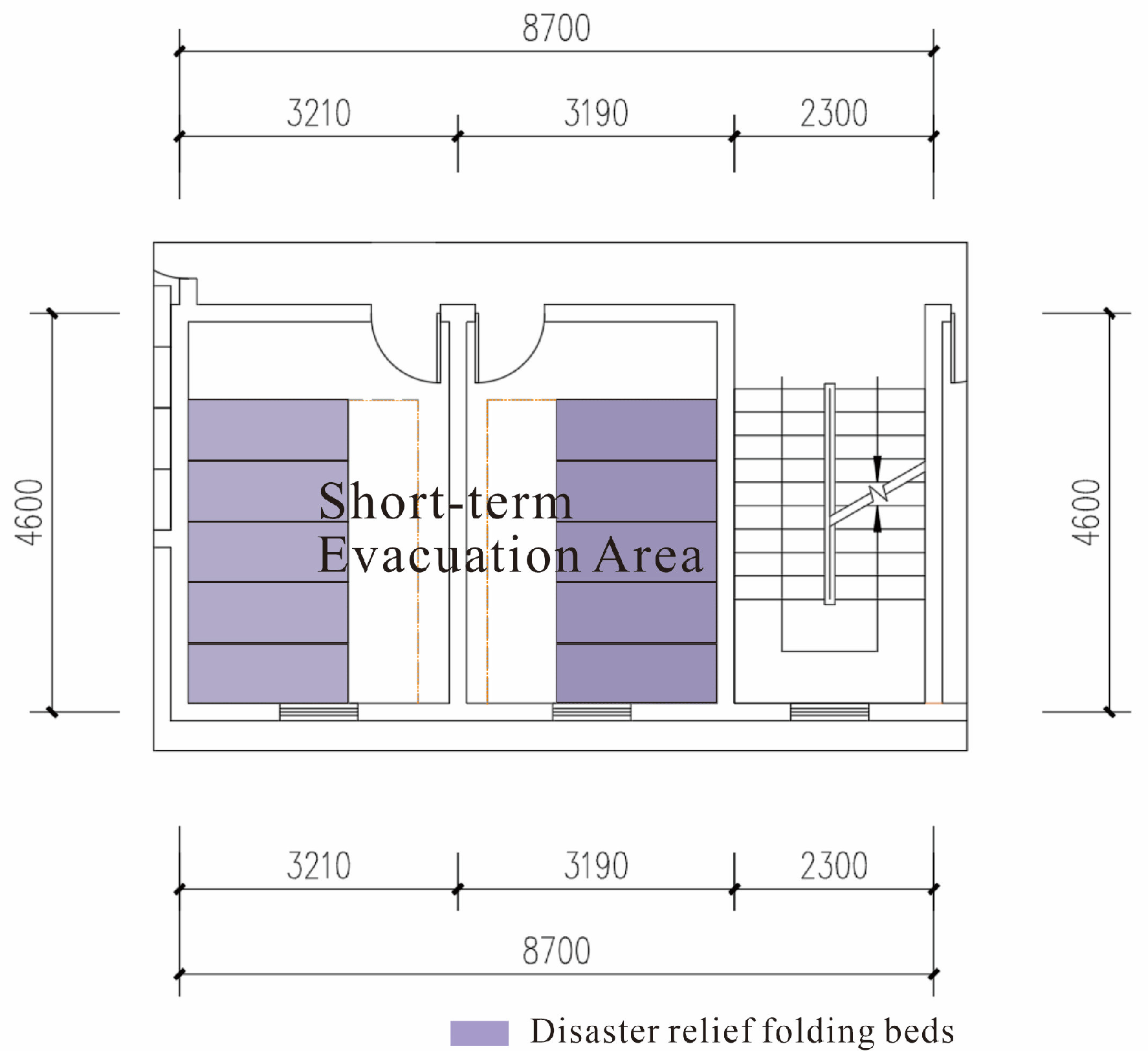 | 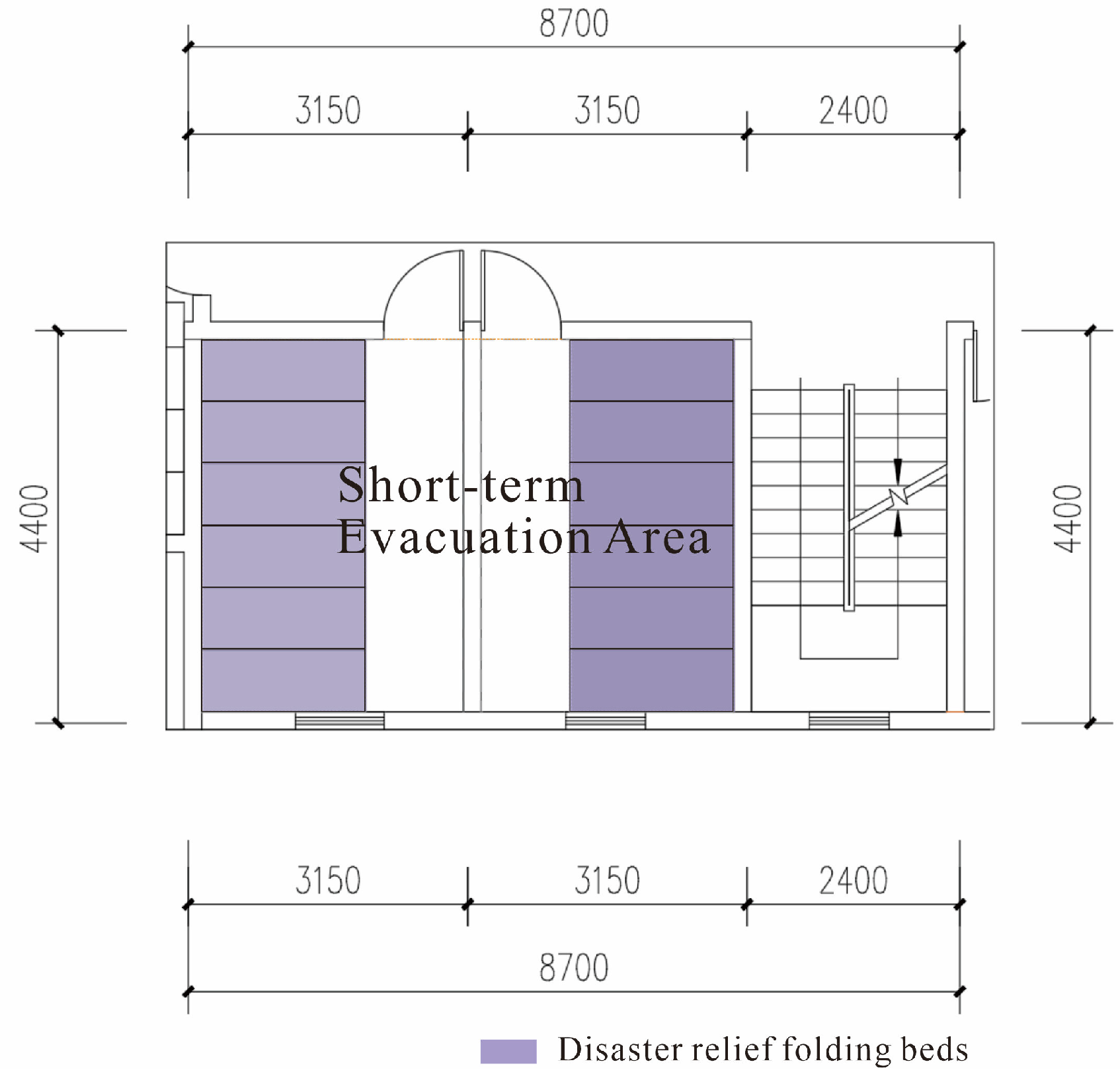 |
| Sheltering Efficiency | Maximum Sheltering Efficiency: 71.80% | (Outward Opening Door) Sheltering Efficiency: 100% |
| Category | Original Length and Width Dimensions (Length: 5.70 m Width: 4.50 m) | Adjusting Dimensions and Door Opening Direction (Length: 5.80 m Width: 3.75 m) |
| Pattern 2 |  |  |
| Sheltering Efficiency | Maximum Sheltering Efficiency: 69.90% | (Outward Opening Door) Sheltering Efficiency: 99.84% |
| Category | Original Length and Width Dimensions (Length: 5.70 m Width: 4.50 m) | Adjusting Dimensions and Door Opening Direction (Length: 5.80 m Width: 4.90 m) |
| Pattern 3 | 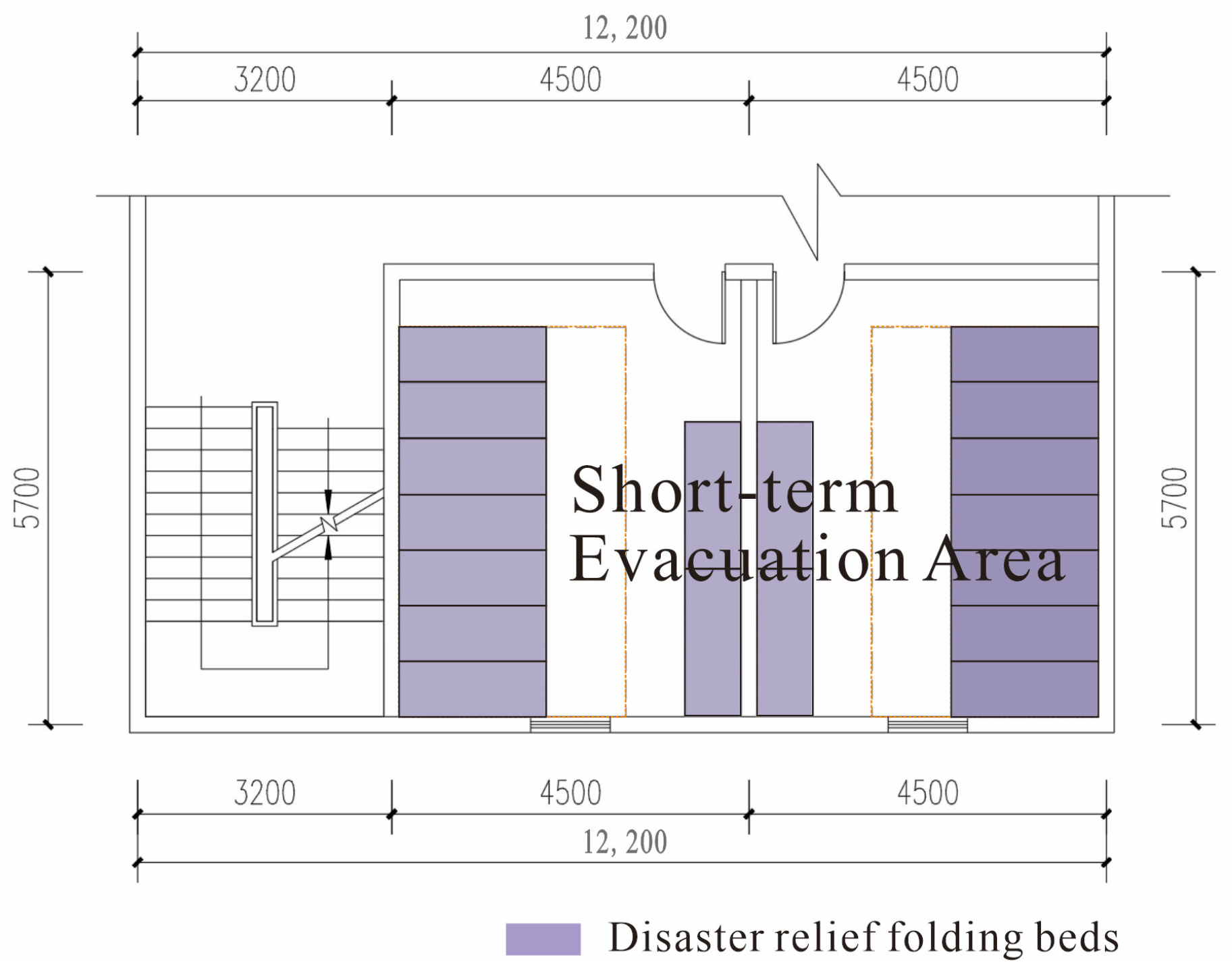 | 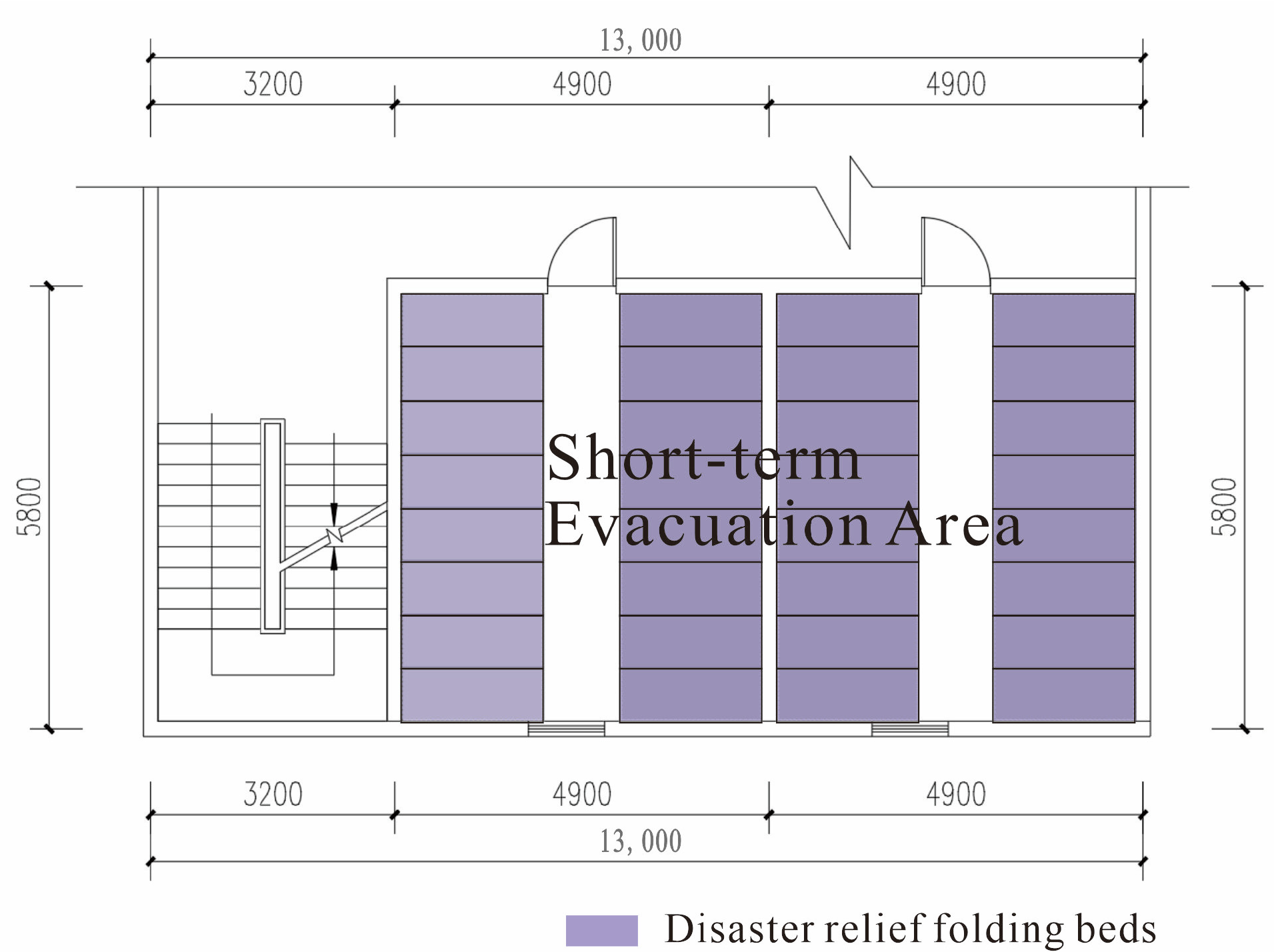 |
| Sheltering Efficiency | Maximum Sheltering Efficiency: 69.90% | (Outward Opening Door) Sheltering Efficiency: 100% |
| Village Name | Original Length and Width Dimensions (Length: 6.80 m Width: 6.00 m; Length: 9.20 m Width: 8.60 m) | Adjustment of Traffic Space and Dimensions (Length: 6.80 m Width: 6.20 m; Length: 9.20 m Width: 8.60 m) |
|---|---|---|
| Ganbao Tibetan Village (Visitor Center) | 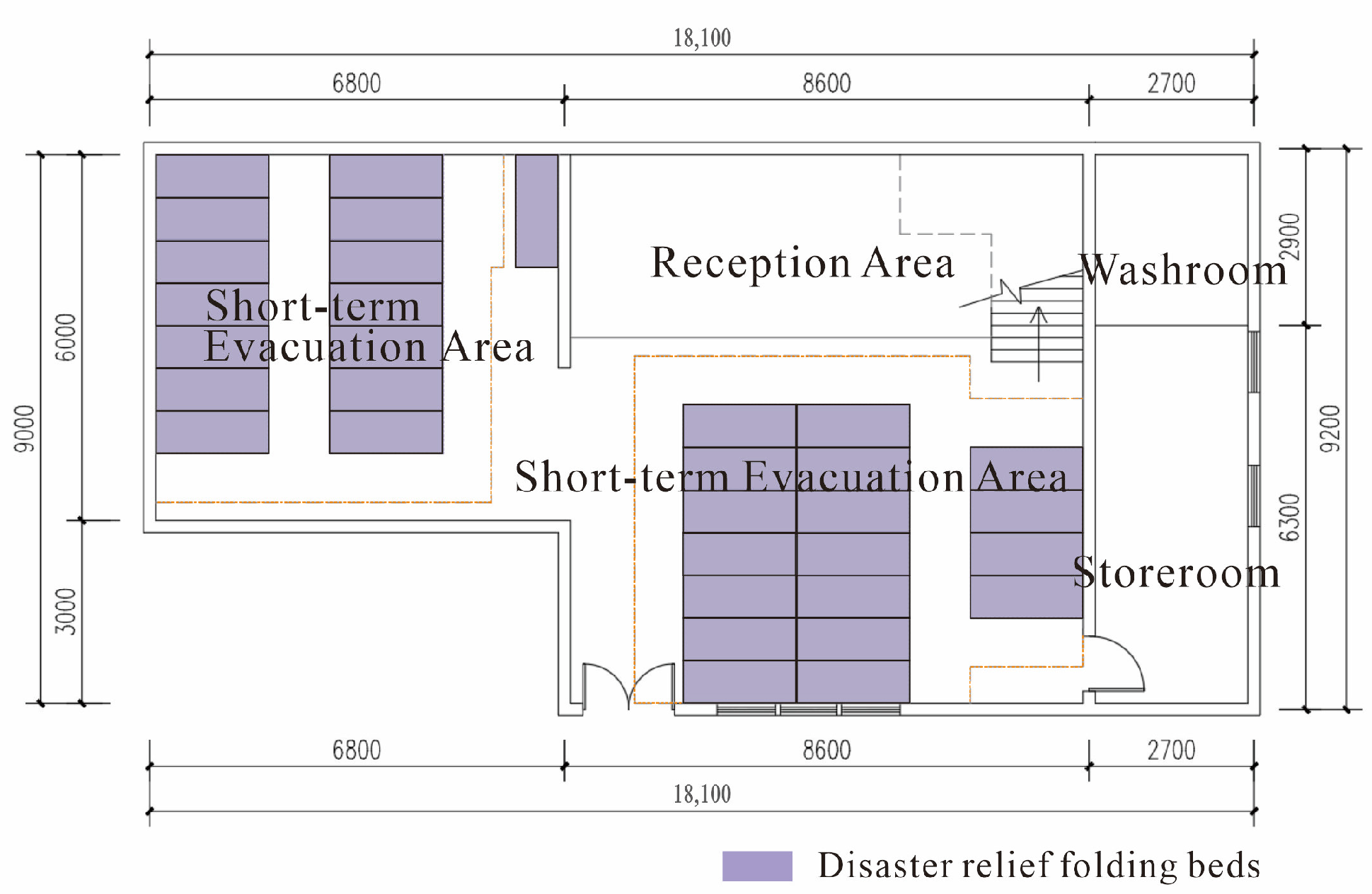 |  |
| Effective Sheltering Area Zone | 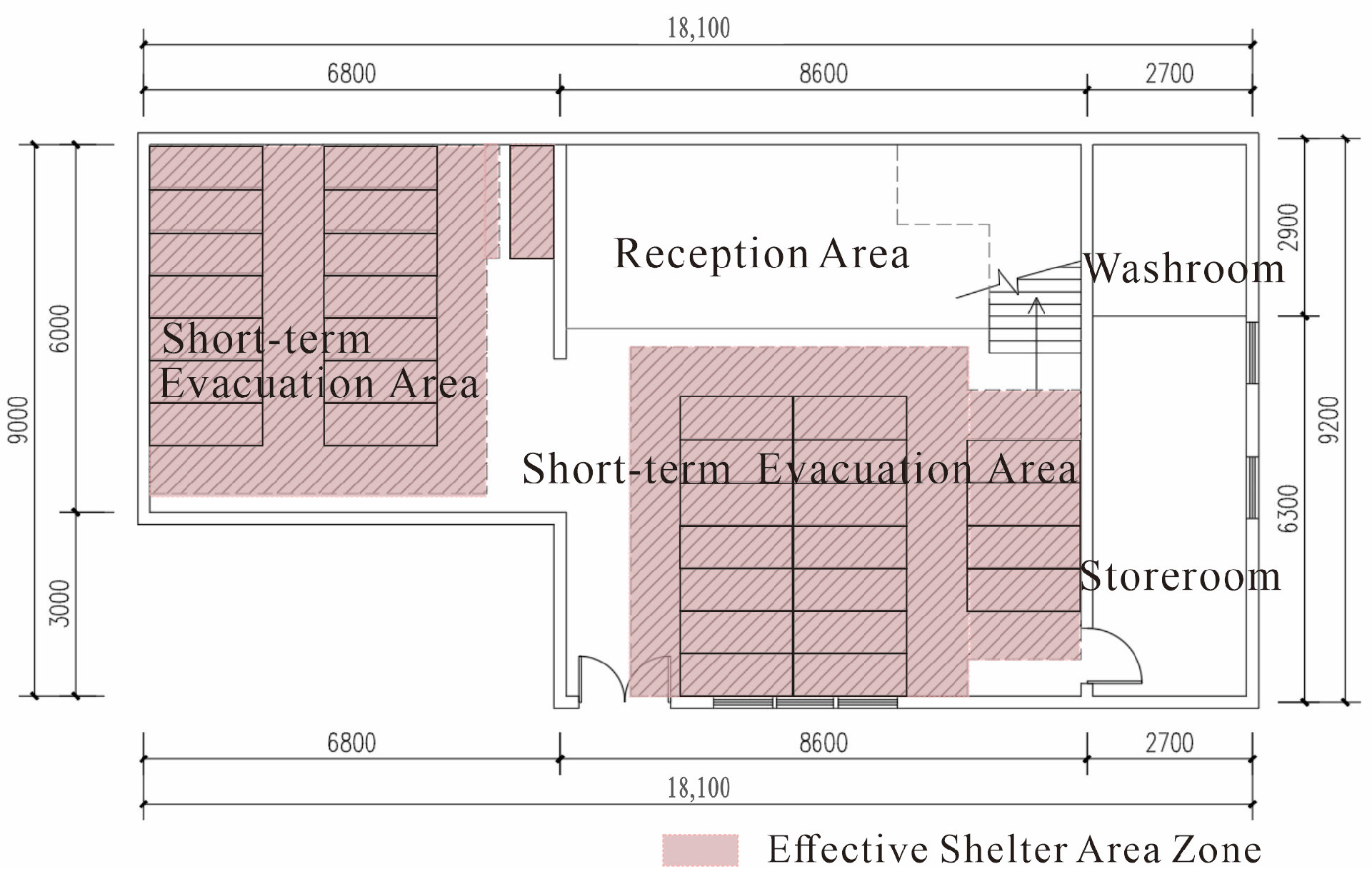 | 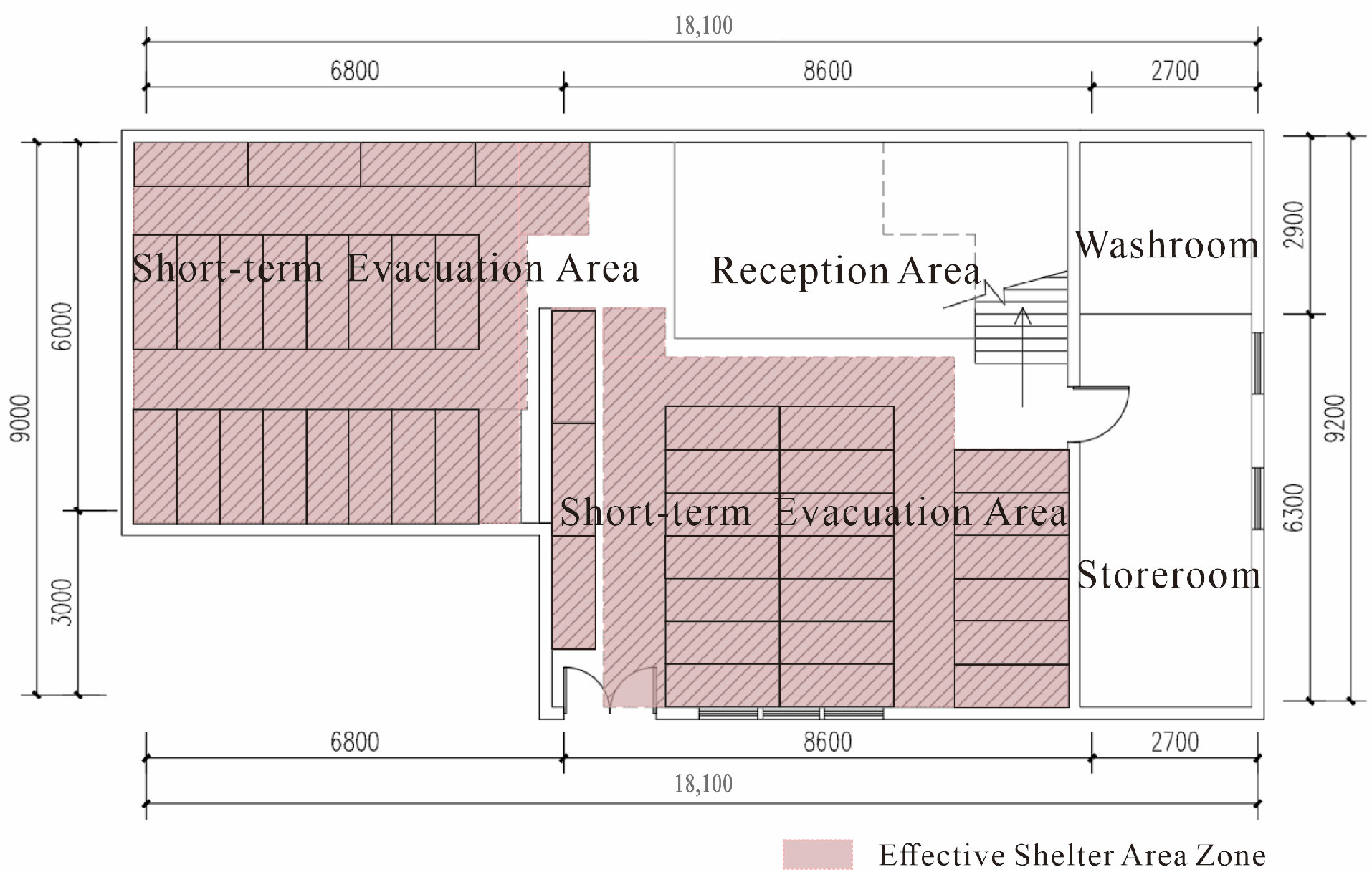 |
| Effective Sheltering Rate | Highest Effective Sheltering Rate: 62.60% | Effective Sheltering Rate (Wall Movement): 72.30% |
| Category | Original Length and Width Dimensions (Length: 6.80 m Width: 6.00 m; Length: 9.20 m Width 8.60 m) | Adjustment of Dimensions and Traffic Space (Length: 6.80 m Width: 6.20 m; Length: 9.20 m Width 8.60 m) |
|---|---|---|
| Pattern 1 | 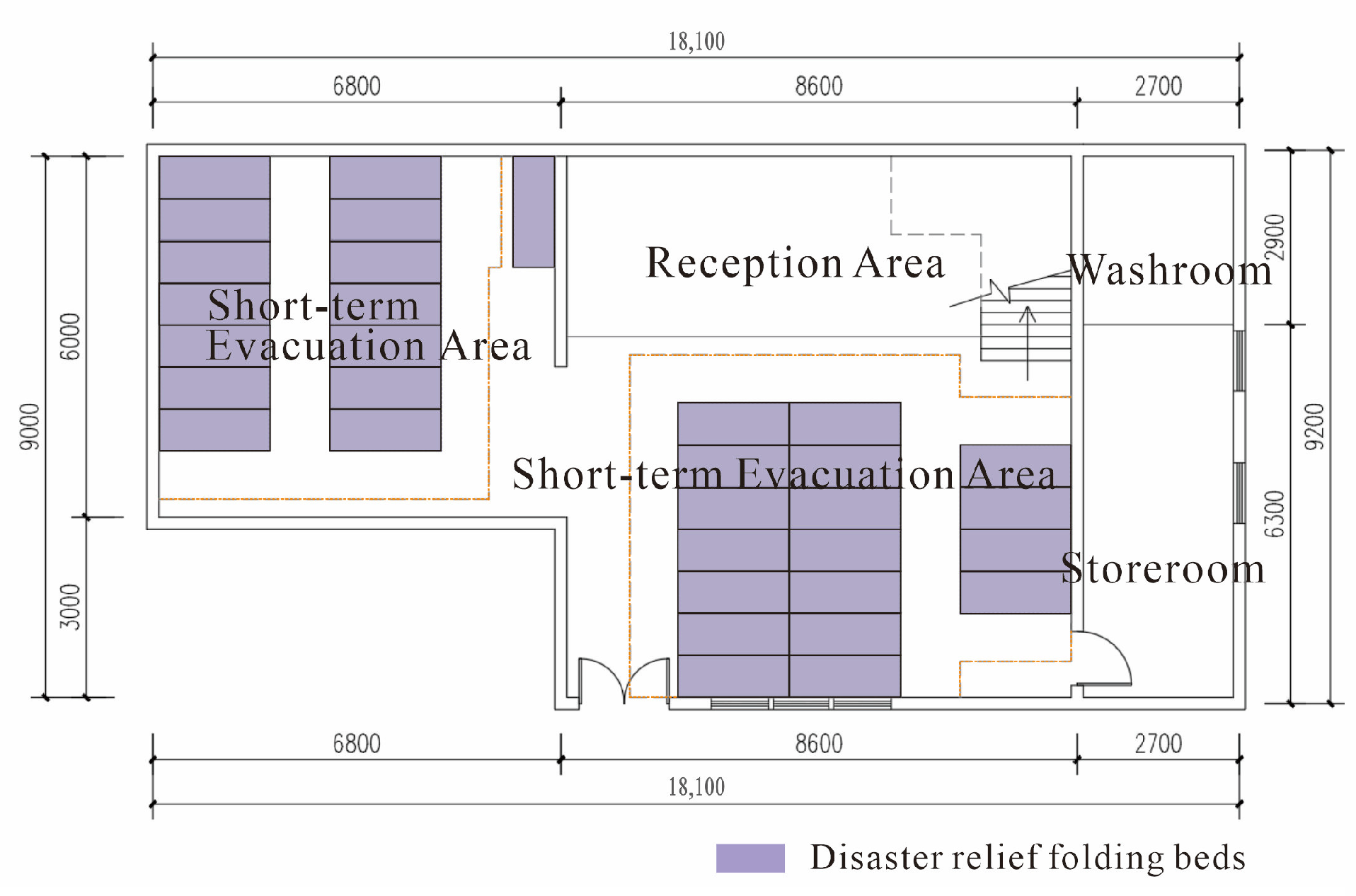 |  |
| Sheltering Efficiency | Maximum Sheltering Efficiency: 62.60% | (With Wall Movement) Effective Refuge Rate: 72.30% |
| Category | Original Length and Width Dimensions (Length: 13.40 m Width: 8.50 m; Length: 19.00 m Width: 15.68 m) | Adjustment of Dimensions and Traffic Space (Length: 13.40 m Width: 8.90 m; Length: 19.00 m Width: 15.68 m) |
| Pattern 2 | 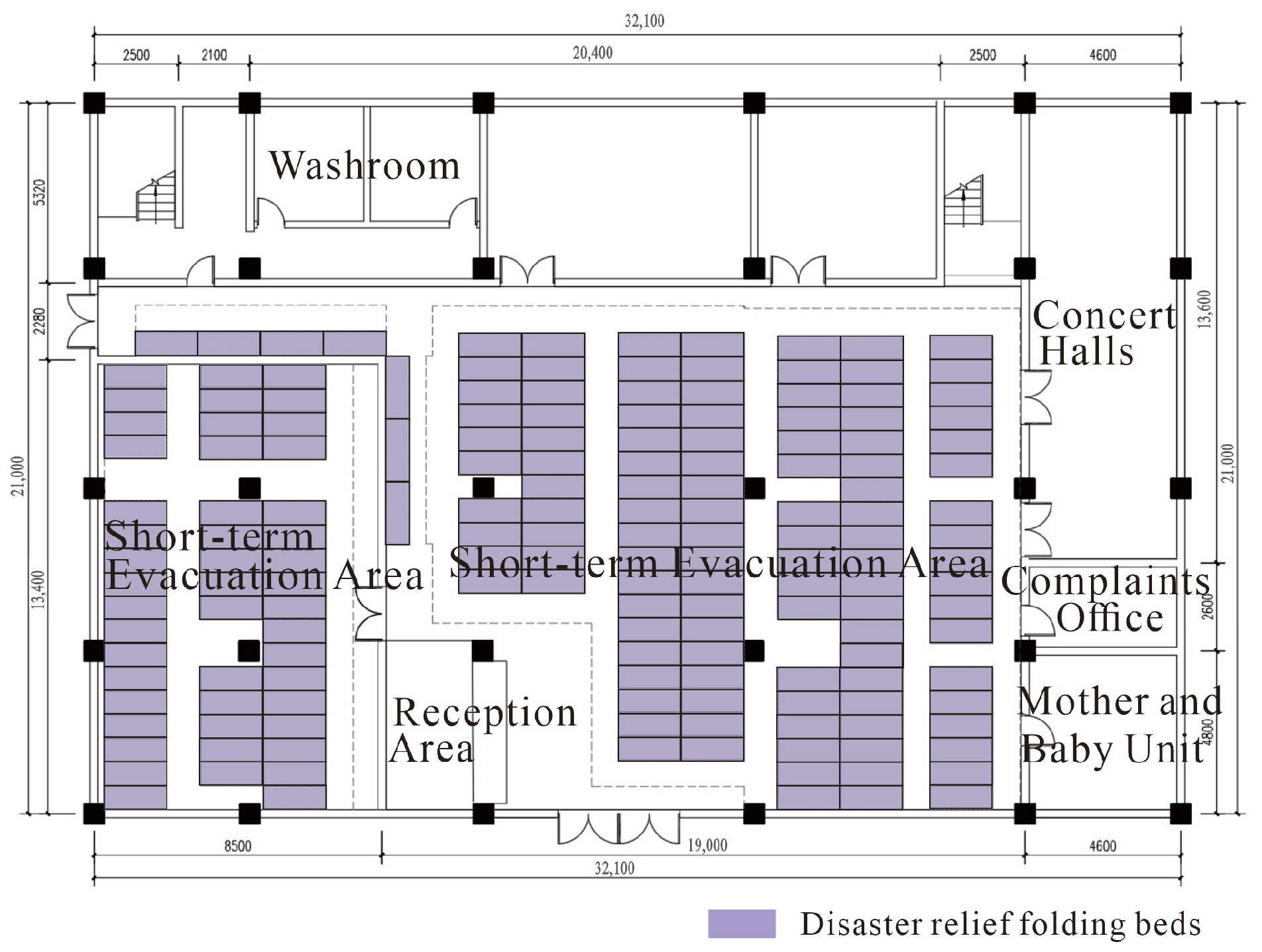 | 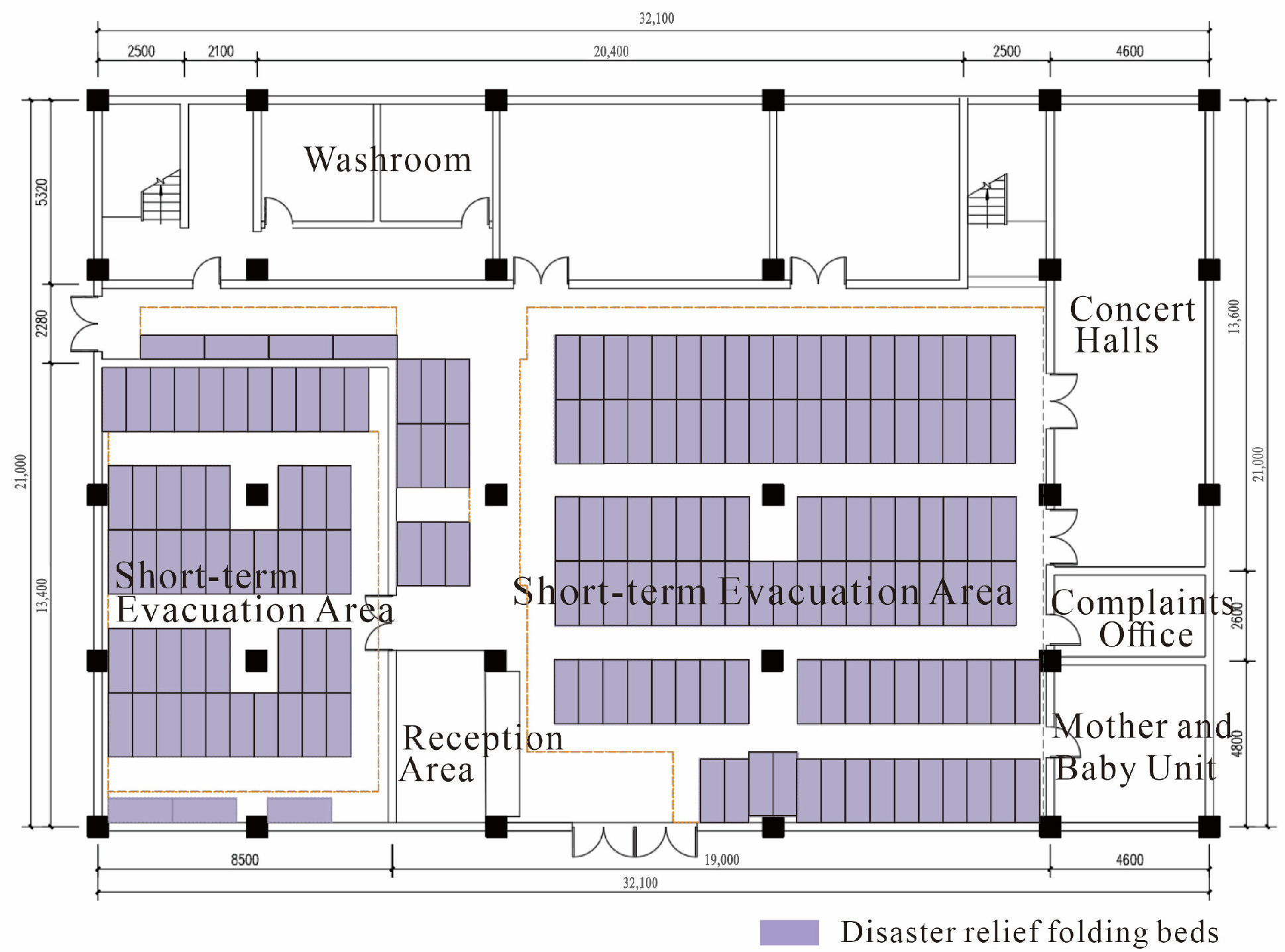 |
| Sheltering Efficiency | Maximum Sheltering Efficiency: 77.30% | Sheltering Efficiency: 79.00% |
Disclaimer/Publisher’s Note: The statements, opinions and data contained in all publications are solely those of the individual author(s) and contributor(s) and not of MDPI and/or the editor(s). MDPI and/or the editor(s) disclaim responsibility for any injury to people or property resulting from any ideas, methods, instructions or products referred to in the content. |
© 2024 by the authors. Licensee MDPI, Basel, Switzerland. This article is an open access article distributed under the terms and conditions of the Creative Commons Attribution (CC BY) license (https://creativecommons.org/licenses/by/4.0/).
Share and Cite
Yong, L.; Zhang, Y.; Wu, J.; Xiong, J. Research on the Effective Sheltering Rates of Public Buildings in Villages in Western Sichuan, China—A Case Study of Ganbao Tibetan Village. Buildings 2024, 14, 2086. https://doi.org/10.3390/buildings14072086
Yong L, Zhang Y, Wu J, Xiong J. Research on the Effective Sheltering Rates of Public Buildings in Villages in Western Sichuan, China—A Case Study of Ganbao Tibetan Village. Buildings. 2024; 14(7):2086. https://doi.org/10.3390/buildings14072086
Chicago/Turabian StyleYong, Lingling, Yin Zhang, Jing Wu, and Jianwu Xiong. 2024. "Research on the Effective Sheltering Rates of Public Buildings in Villages in Western Sichuan, China—A Case Study of Ganbao Tibetan Village" Buildings 14, no. 7: 2086. https://doi.org/10.3390/buildings14072086
APA StyleYong, L., Zhang, Y., Wu, J., & Xiong, J. (2024). Research on the Effective Sheltering Rates of Public Buildings in Villages in Western Sichuan, China—A Case Study of Ganbao Tibetan Village. Buildings, 14(7), 2086. https://doi.org/10.3390/buildings14072086









